Complete Solutions to Illustration of chapter AROMATIC COMPOUNDS AND ALKYL AND ARYL HALIDES of Class 12 book with complete answers and questions
| Class 12 | CHEMISTRY |
| Chapter | AROMATIC COMPOUNDS AND ALKYL AND ARYL HALIDES |
| CENGAGE CHEMISTRY | Illustration |
| Number Of Questions | 57 |
| Academic Year | 2023-24 |
Name of the follwing groups:
a. `C_(6) H_(5)-`, b. `C_(6)H_(5)CH_(2)-`
C. (C_(6)H_(5))_(2) CH-`, d. `(C_(6)H_(5))_(3) C-`
e. `C_(6) H_(5) CH-`, f. `C_(6) H_(5) -overset(|)underset(|)(C)-`03:44View SolutionWrite the name of phenyl-substituded groups:
a. `C_(6)H_(5) overset(|)(C)Hme`, b `C_(6)H_(5) CH_(2)-`
C. `C_(6) H_(5) CH = CH-`, d. `C_(6)H_(5) == CHCH_(2)-`02:00View SolutionWrite the sturctures of the following compounds:
a. Adjacent tribromobenzene
b. Unsymmetrical trimethyl benzene
c. Symmetrical triethyl benzene05:55View SolutionName of the following compounds:
a.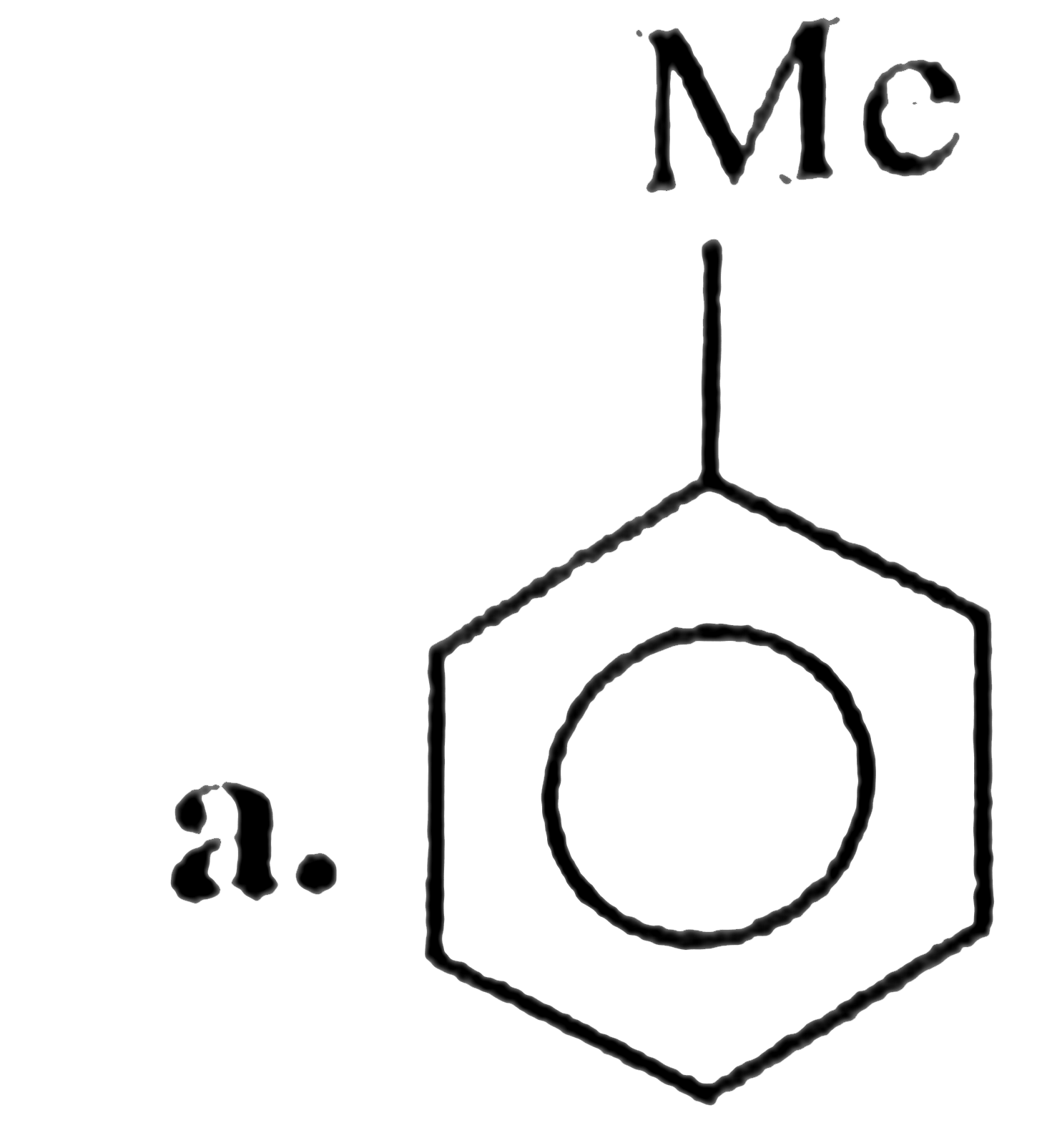 , b.
, b. 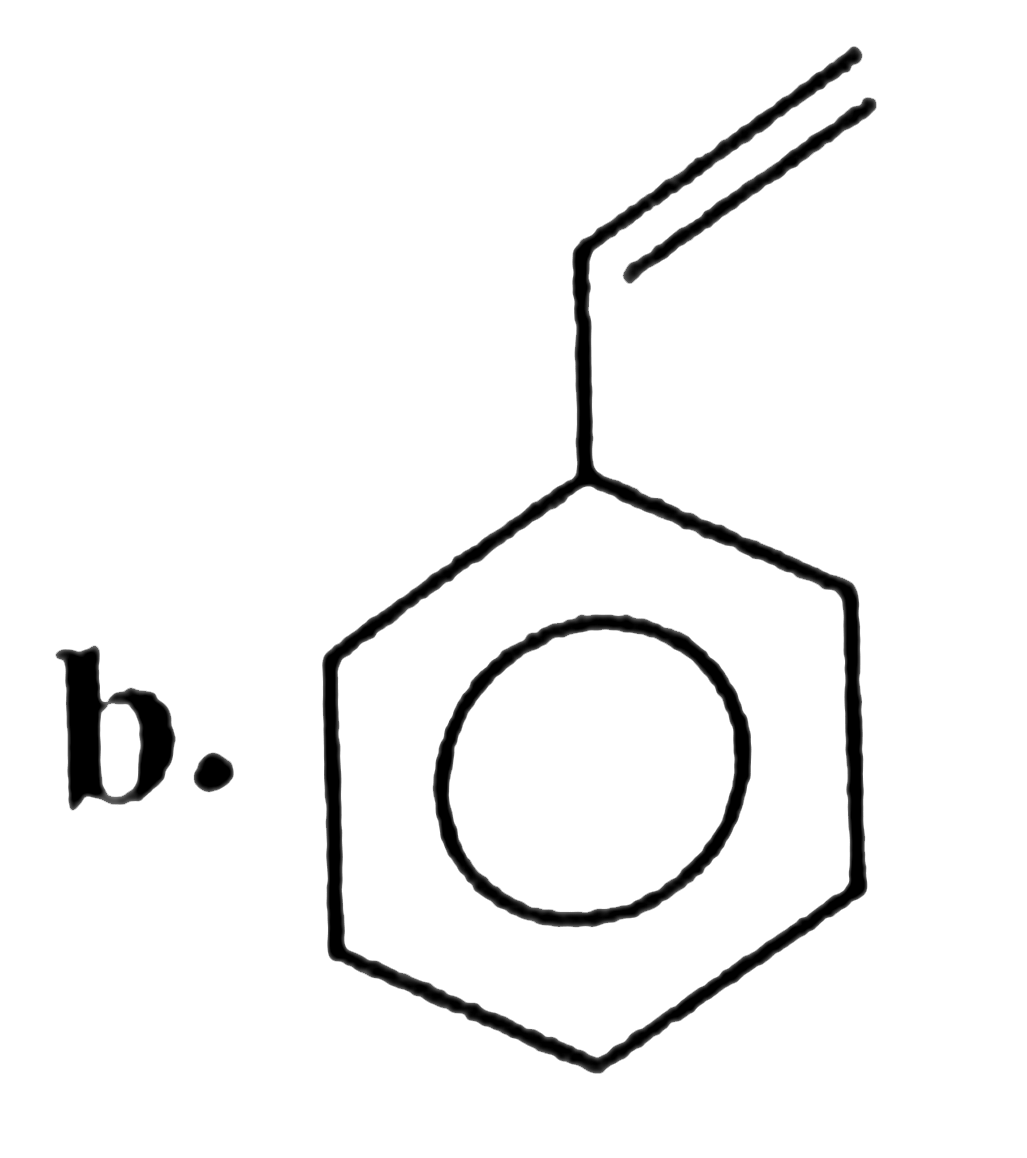
c.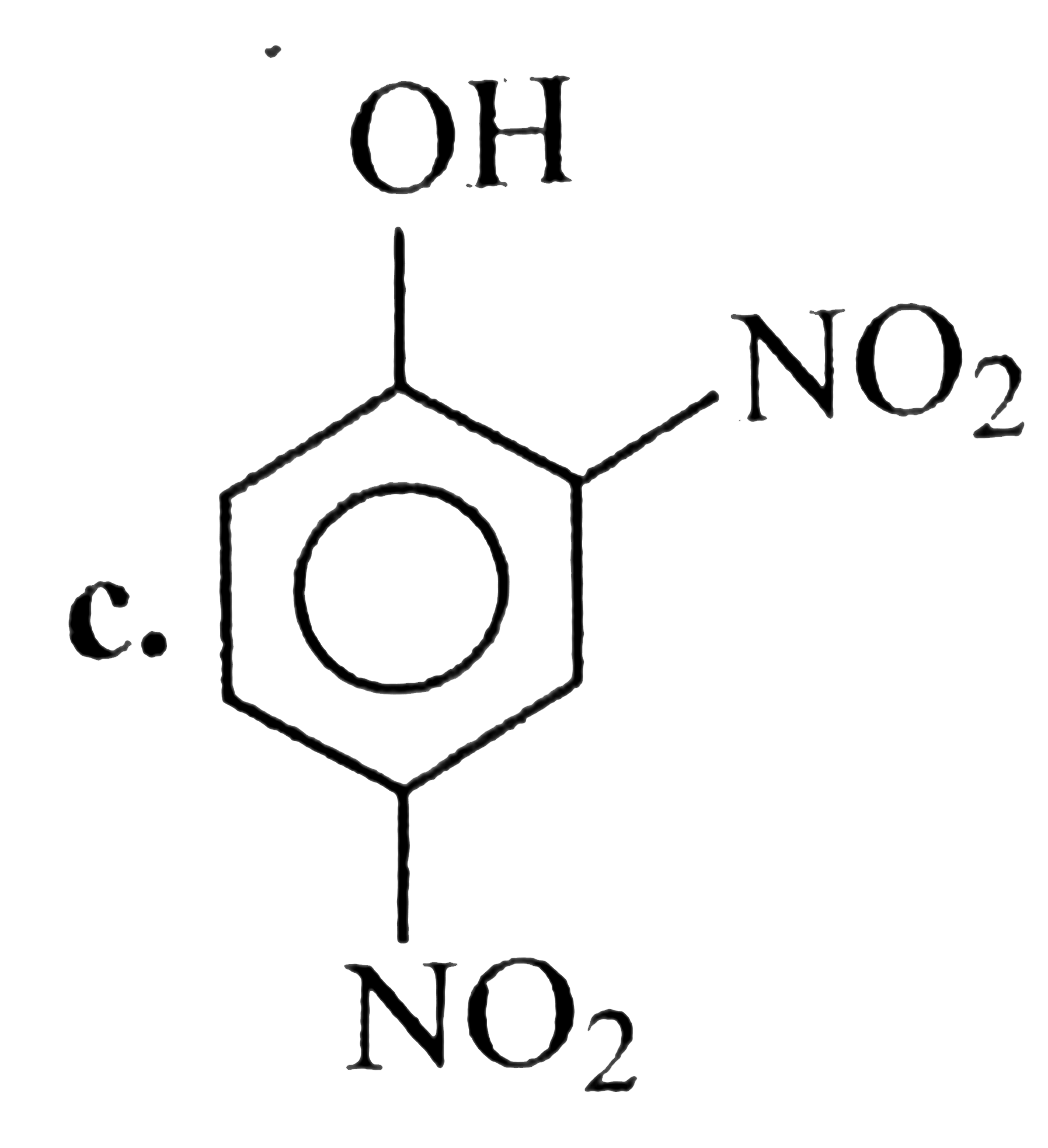 , d.
, d. 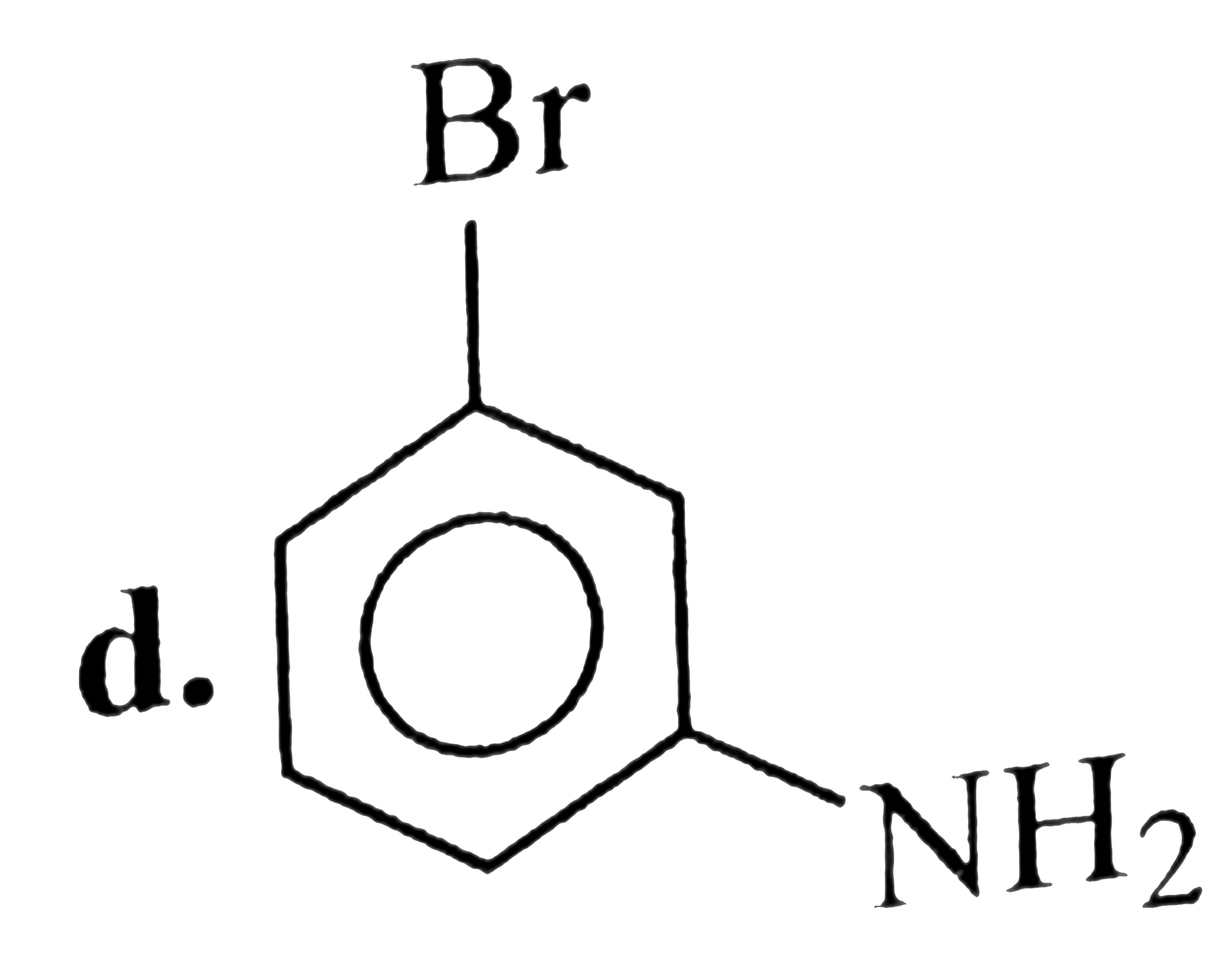
e. , f.
, f. 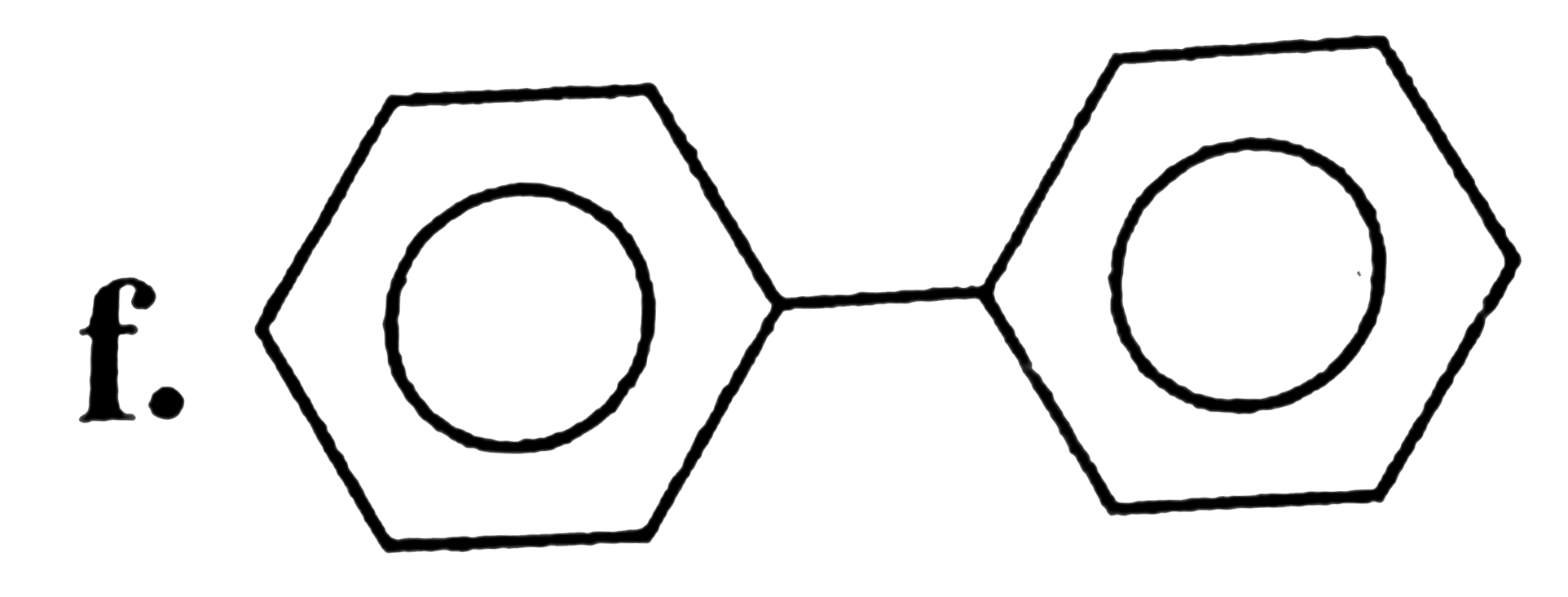
g.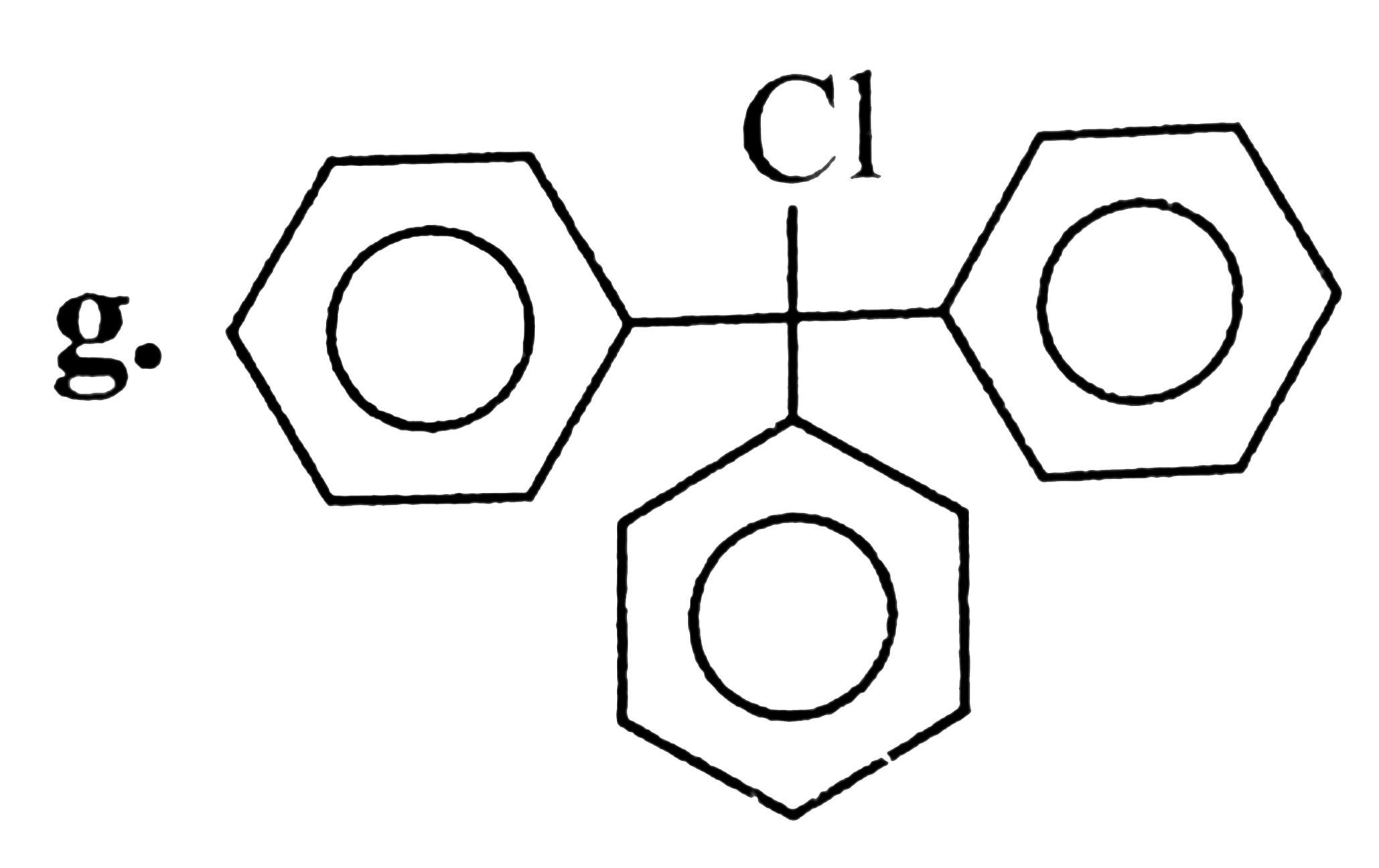 , h.
, h. 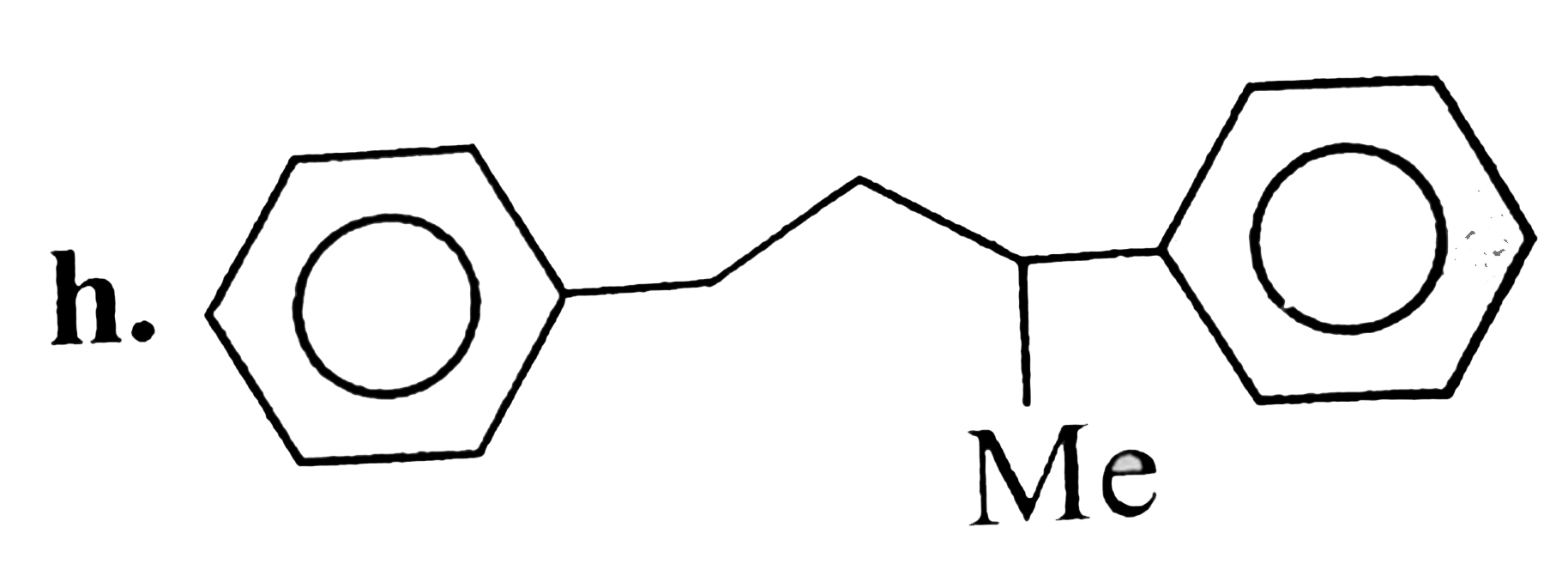
i. , j.
, j. 
k. , l.
, l. 
m. , n.
, n. 
o.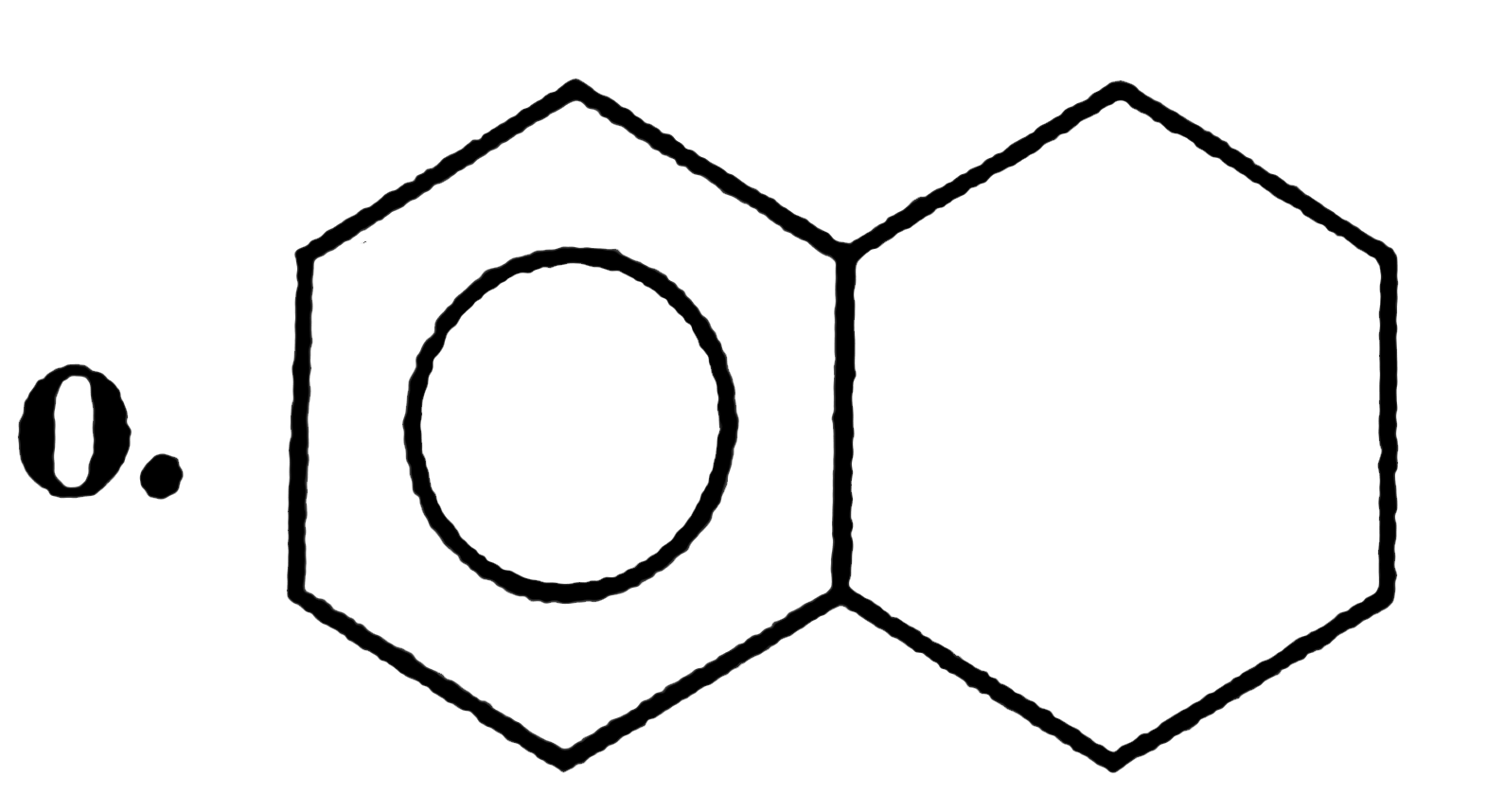 , p.
, p. 
q.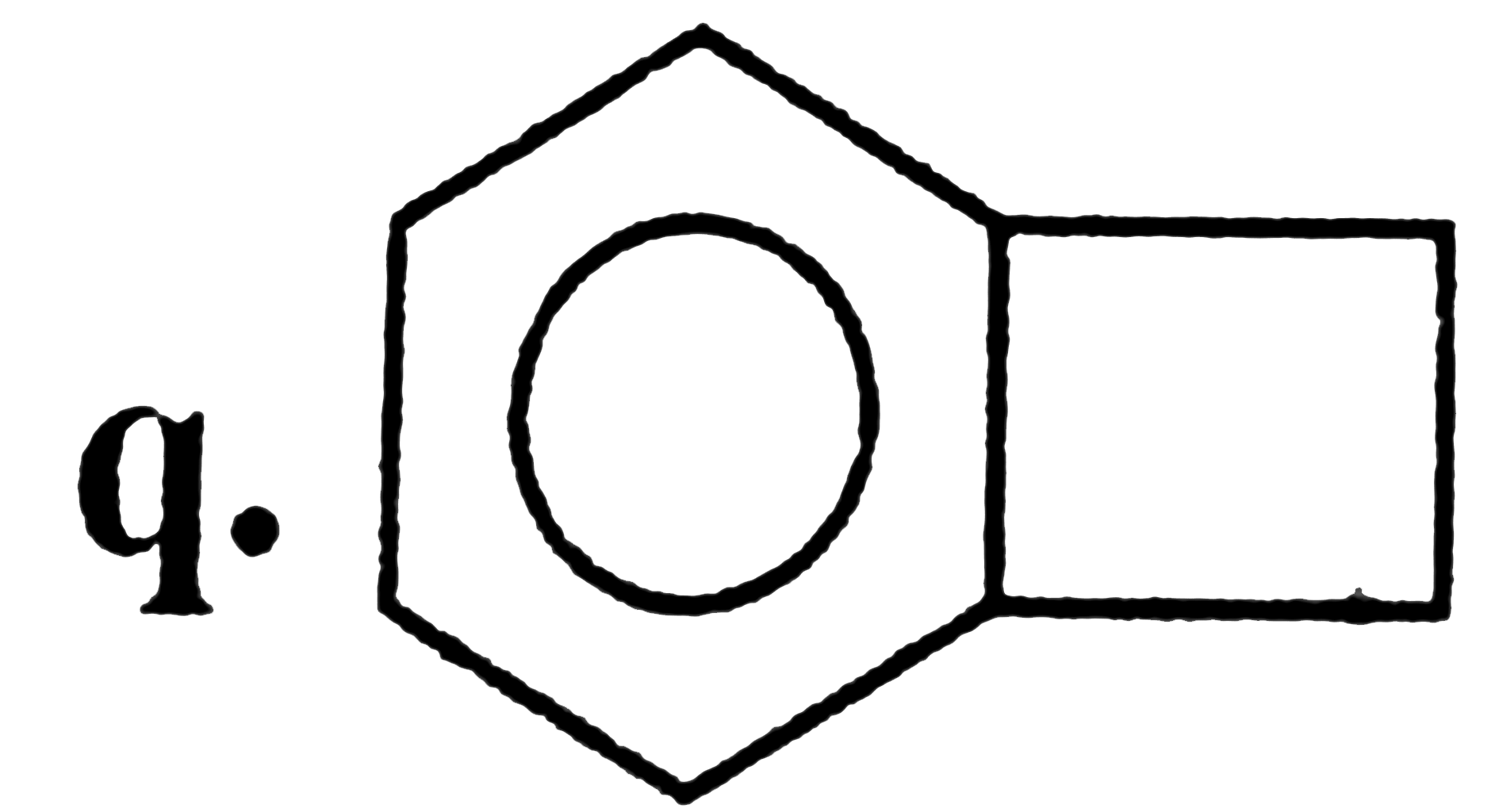 , r.
, r. 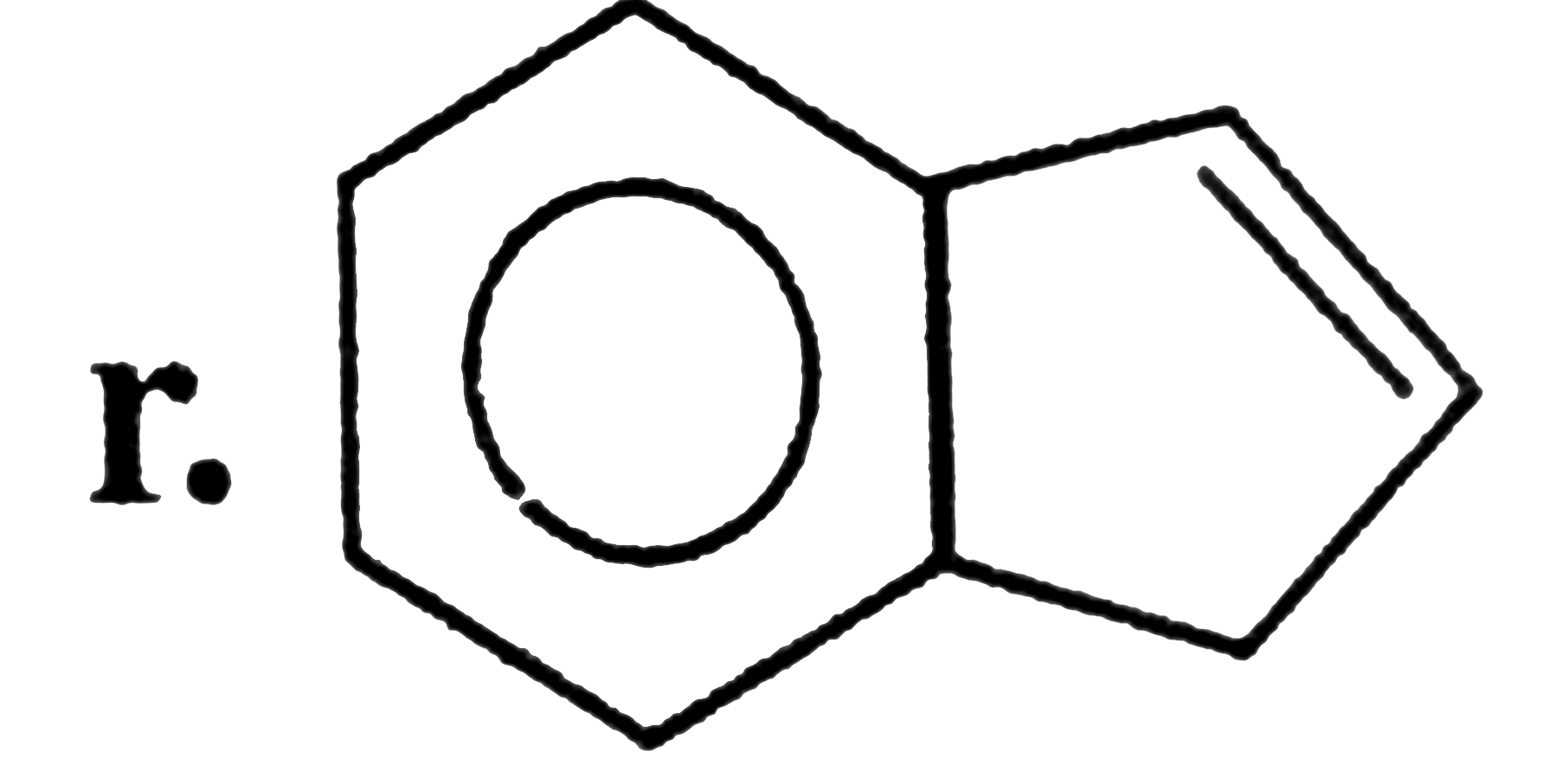 View Solution
View SolutionWrite the names and structures of the following compounds: , a. `DDT` b. Acteophenone
02:06View SolutionSelect the aromatic, anti-aromatic, and non-aromatic a compounds.
1. ,2. ,3.
4. ,5
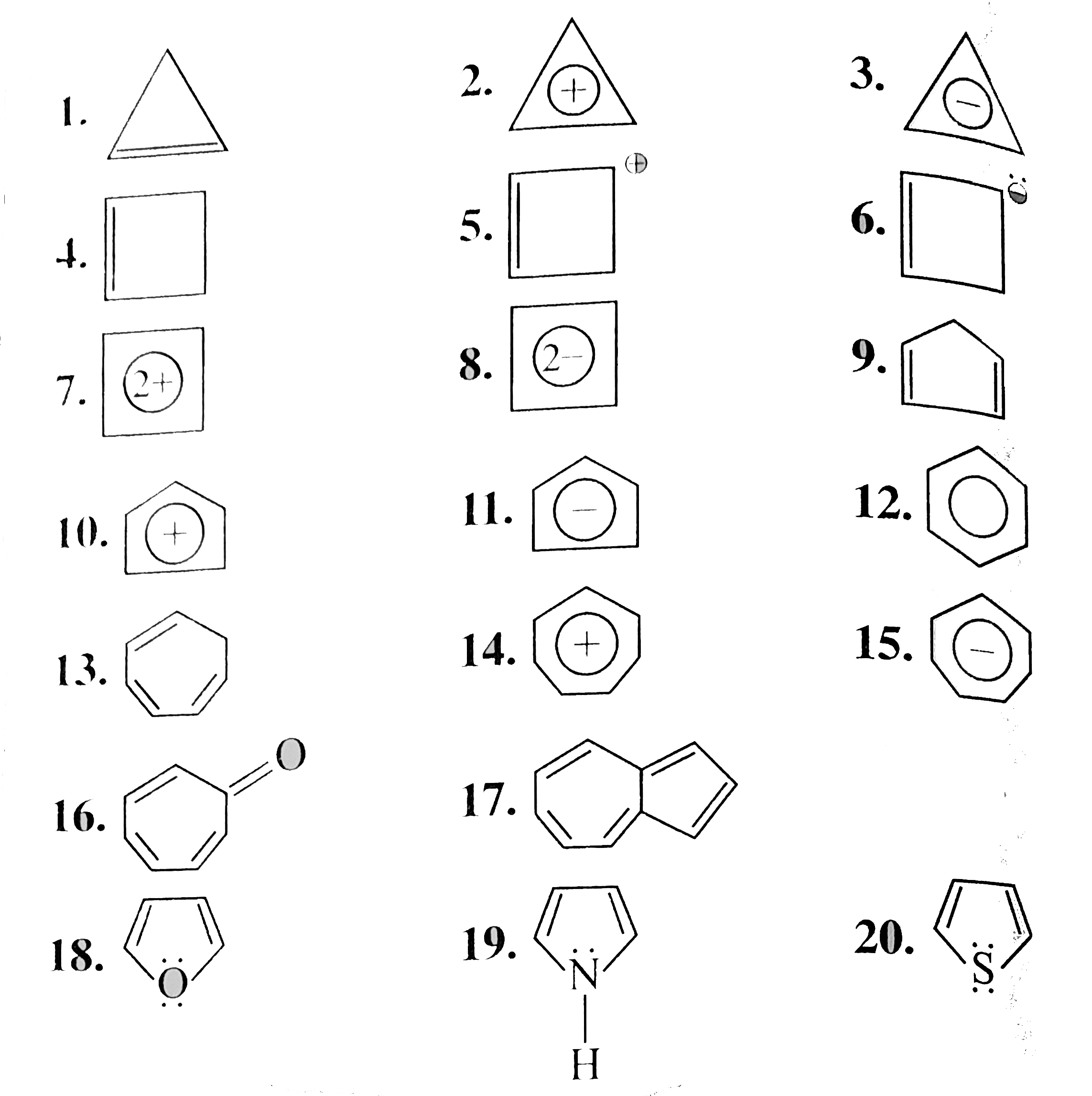
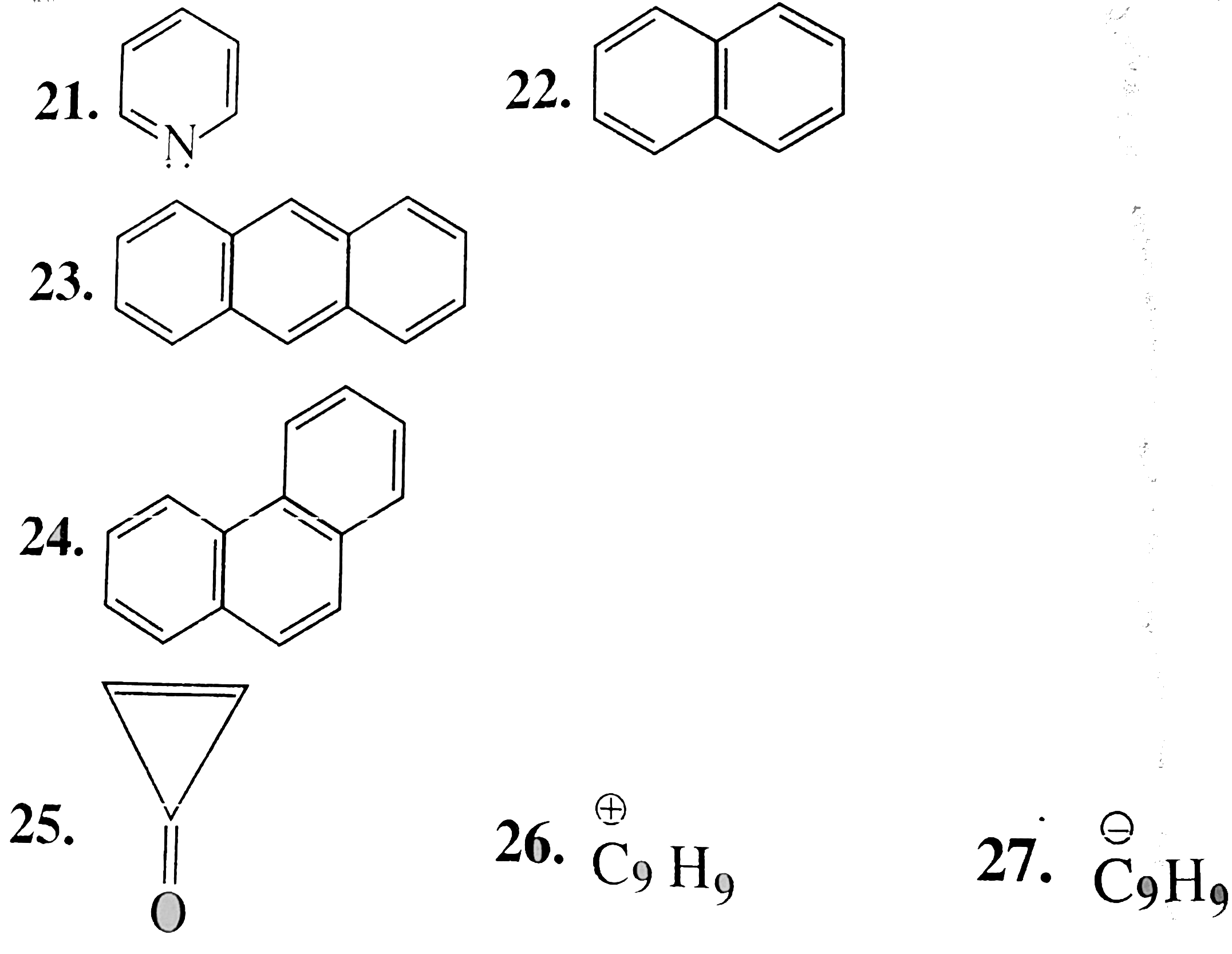

 03:52View Solution
03:52View Solutiona.
`7-` Bromocycloheptraiene (tropylium bromide) completely dissociates in water and gives a yellow precipiate of `AgBr` with `AgNO_(3)`. Why?
(b) Why is cyclopentadiene `(K_(a) = 10^(-15))` much more acidic than `1,3-` cyclohexadience?
C. Explain the following `1,3,5`-cycloheptatrience through a cycle, planner triene with six `pi vec(e)'s` is not armoatic, whereas tropolone behaves like a phenol.View SolutionAnthrance has a resonance energy of `351 kJ mol^(-1)` and the resonance energy of benzence is 150.5 kJ mol^(-1)`. Which of the two is more easily oxidised or reduced ?
02:47View Solutiona. Compare the following reaction.
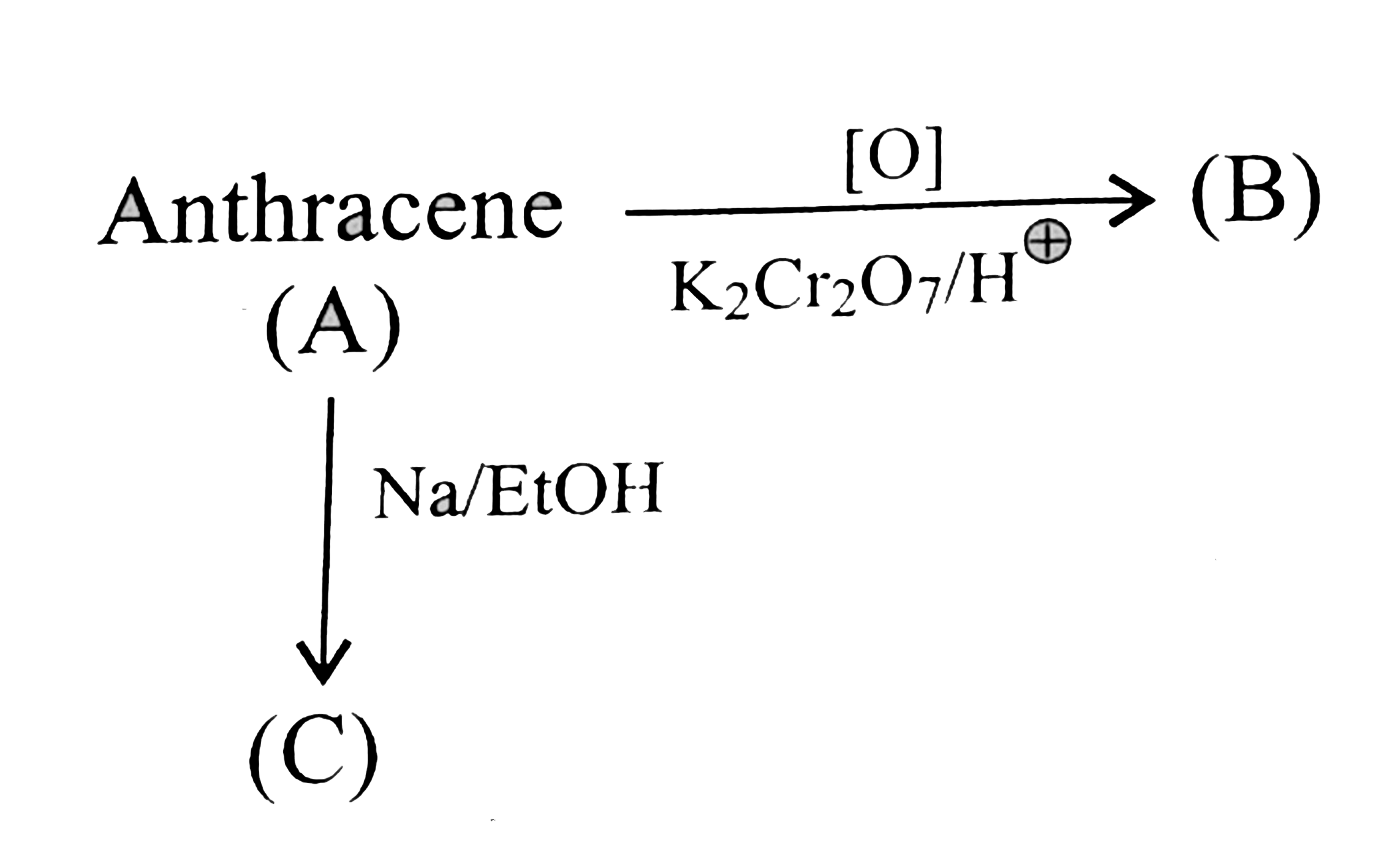 02:37View Solution
02:37View SolutionComplete the reactions.
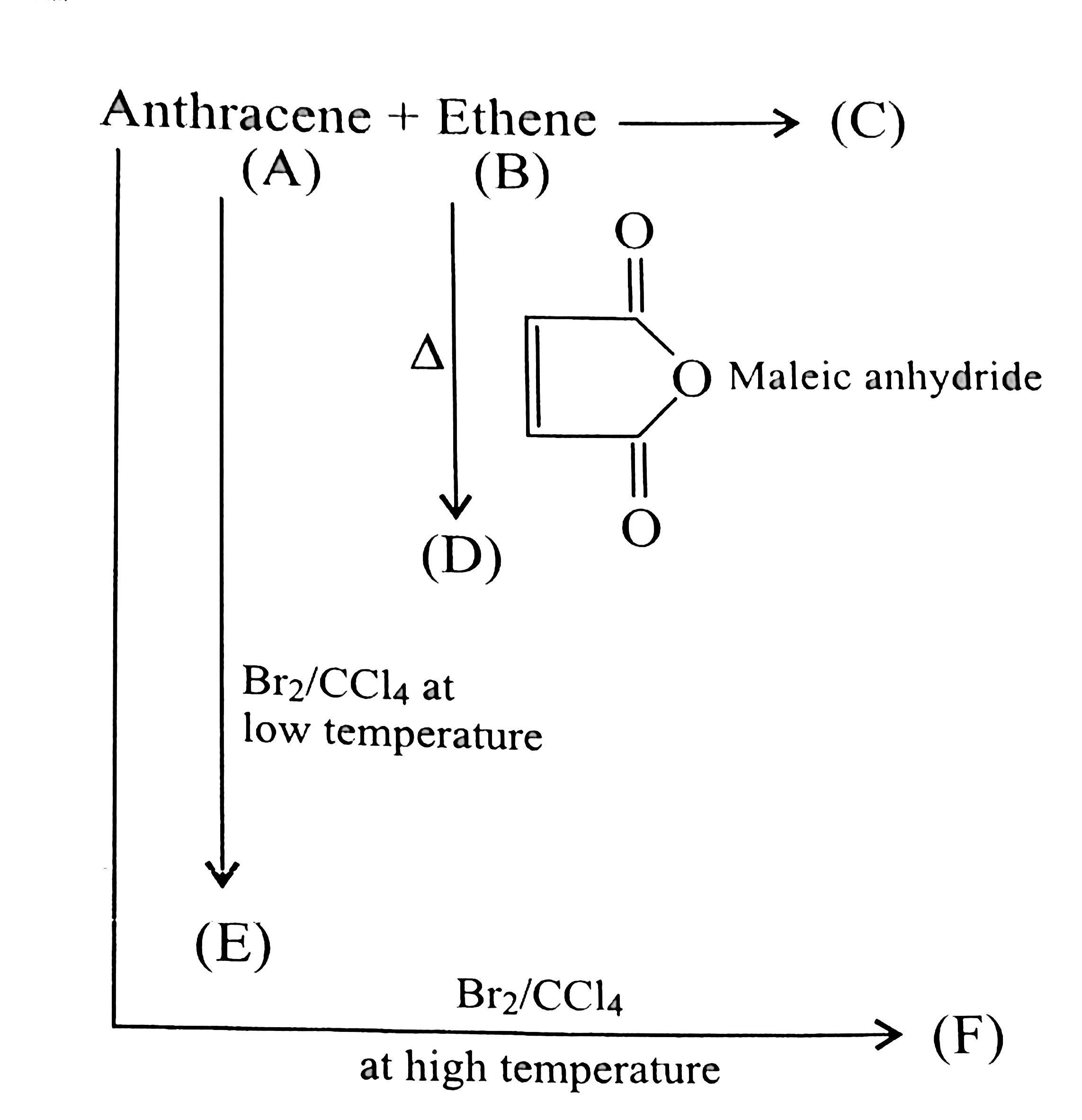 View Solution
View SolutionComplete the reactions.
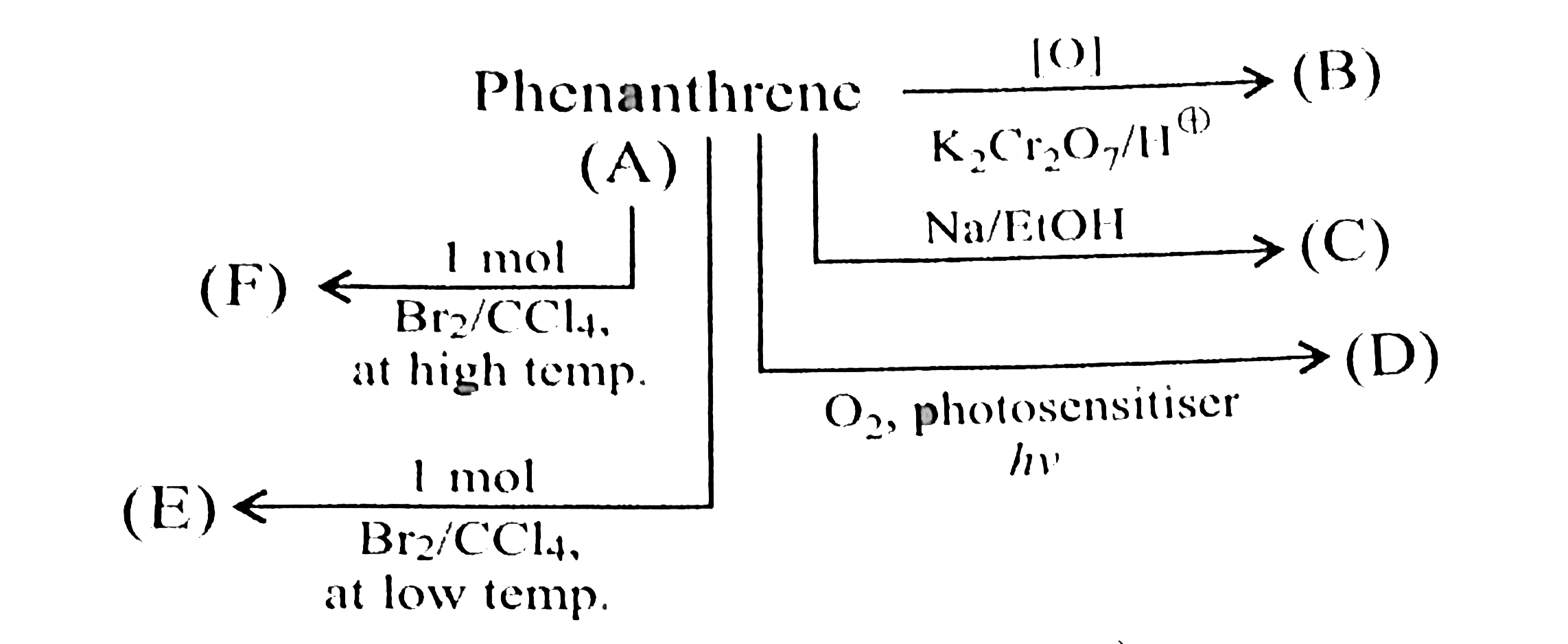 10:44View Solution
10:44View SolutionOut of benzene naphtahlene anthracene, and phenantrene, which is more reactive in the Diels - Alder reaction?
View SolutionAmong the following in which cases is the `o//p` ratio on nitration more the first compound?
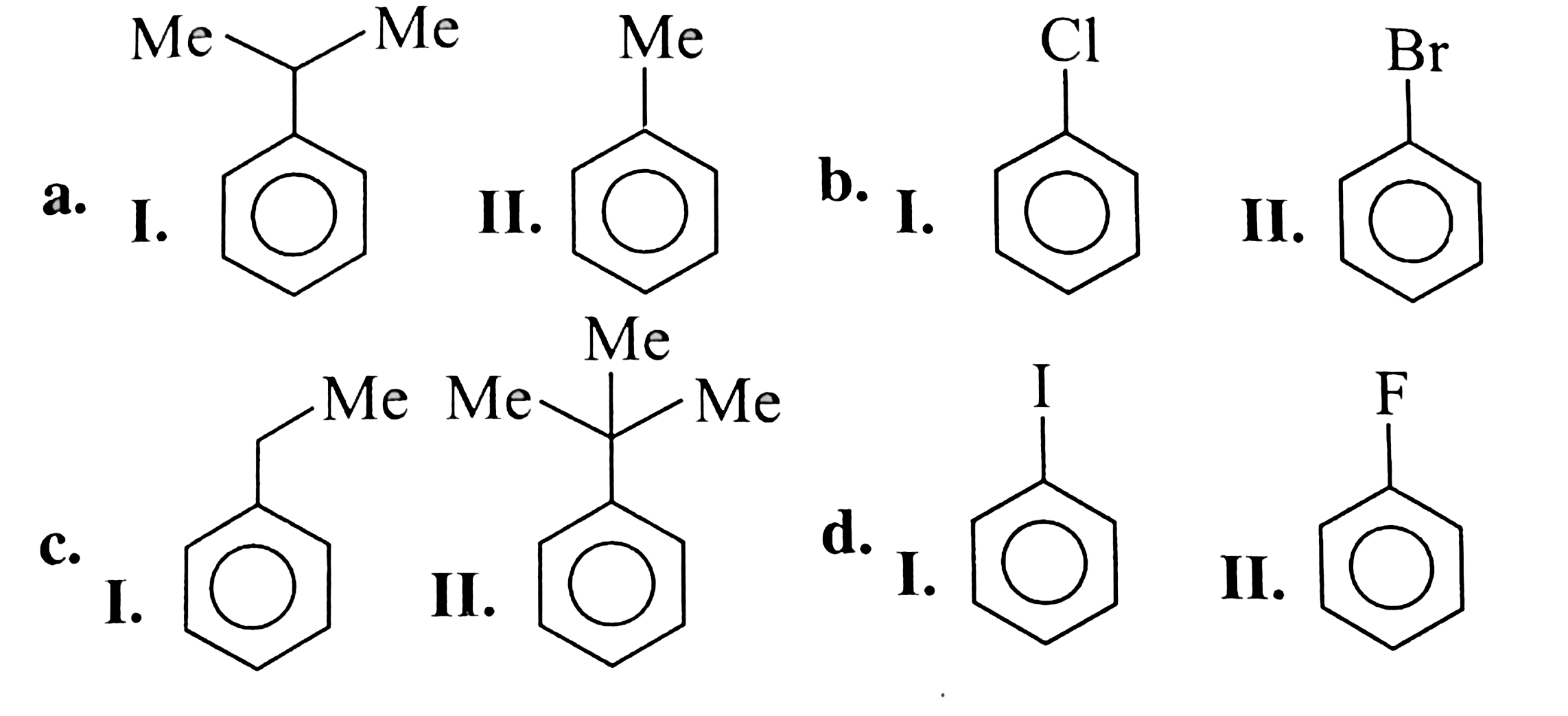 03:18View Solution
03:18View SolutionWhy are `(o + p)` in ratious for the `SE` reaction (e.g. nitraction) of toluene and `PhCF, 32.3` and `0.14`, respectively ?
07:58View SolutionArrange the following in the decreasing of `mu`.
 05:04View Solution
05:04View SolutionWrite resonance-contributing structures for the intermedicate carbocation (arenonium ion) of
(i) Phenol
(ii) Nitrobenzene with electrophile `CI^(o+)` at the
a. ortho-,
b. para-, and
c. meta-positions.View Solutiona. Why are `overline(e)` donating groups, such as `(-NH_(2))` (`-`OR), `(-R) o-` and `p-` directing towards `SE` reaction? Explain by an example.
b. Why are `overline(e)` withdrawing groups, [such as `(-NO_(2), (-SO_(3)H),(-CN),(-COOH)`, etc].`m-` direection towards `SE` reaction? explain by example.
c. Although halogens are `overline(e)` withdrawing yet they are `o-` and `p-` directing towards `SE` reaction. Why?06:31View SolutionArrange the following compounds in decreasing order of their property as indicated:
a. Reactivity and orientation of (I) `Ph - underset(..)overset(o+)(S) - Et_(2)` and (II) `PhNO`.
Activating effects of the following `o,p-` directions:
I. `-O^(o-). II, `-OH`, III. `-NH_(2)` IV. -NHCOCH_(3)` V. `-OCOCH_(3)`
c. Respectivity and orientation of I. `PhOEt` and II. `PhSEt`
d. Categories the following subsituents as:
I. Activating,
ii. Deactivating,
iii. `o, p`, or `m-` directing.
I.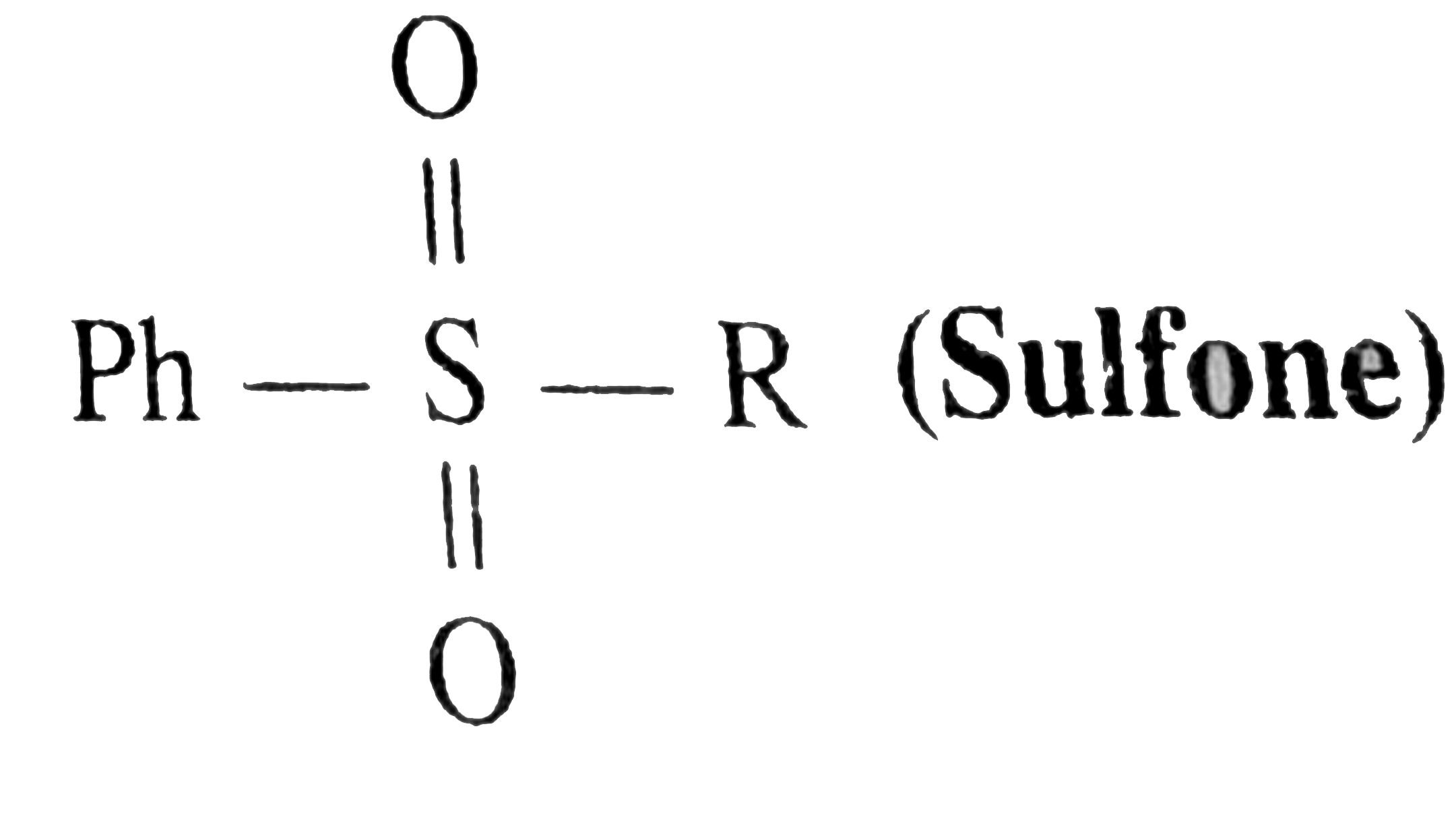
II.
III. `Ph - ddot(S) - R`
`SE` reactivty of:
I. `PhNO`, II.
f. `SE` reactivity and orientation of:
1. `PhF`, II. `PhCl`, III. PhBr`, IV. `Phl`View SolutionIdentify the electrophile and base for each for the following:
a. `HNO_(2) + H^(o+)`, b. `Ibr + ZnCl_(2)`
c. `Icl + ZnCl_(2)`, d. `HOCl + H^(o+)`
e. `HNO_(3)`
`H_(2) S_(2) O_(7)`View SolutionGive the decreasing order of the relative reactivity towards `SE` reaction of the following compounds.
a. I. Benzene, II. Phenol, III. Aniline, IV. Chlorobenzene05:00View SolutionIndicate by an arrow the positon(s) where `SE` reaction takes place in the following:
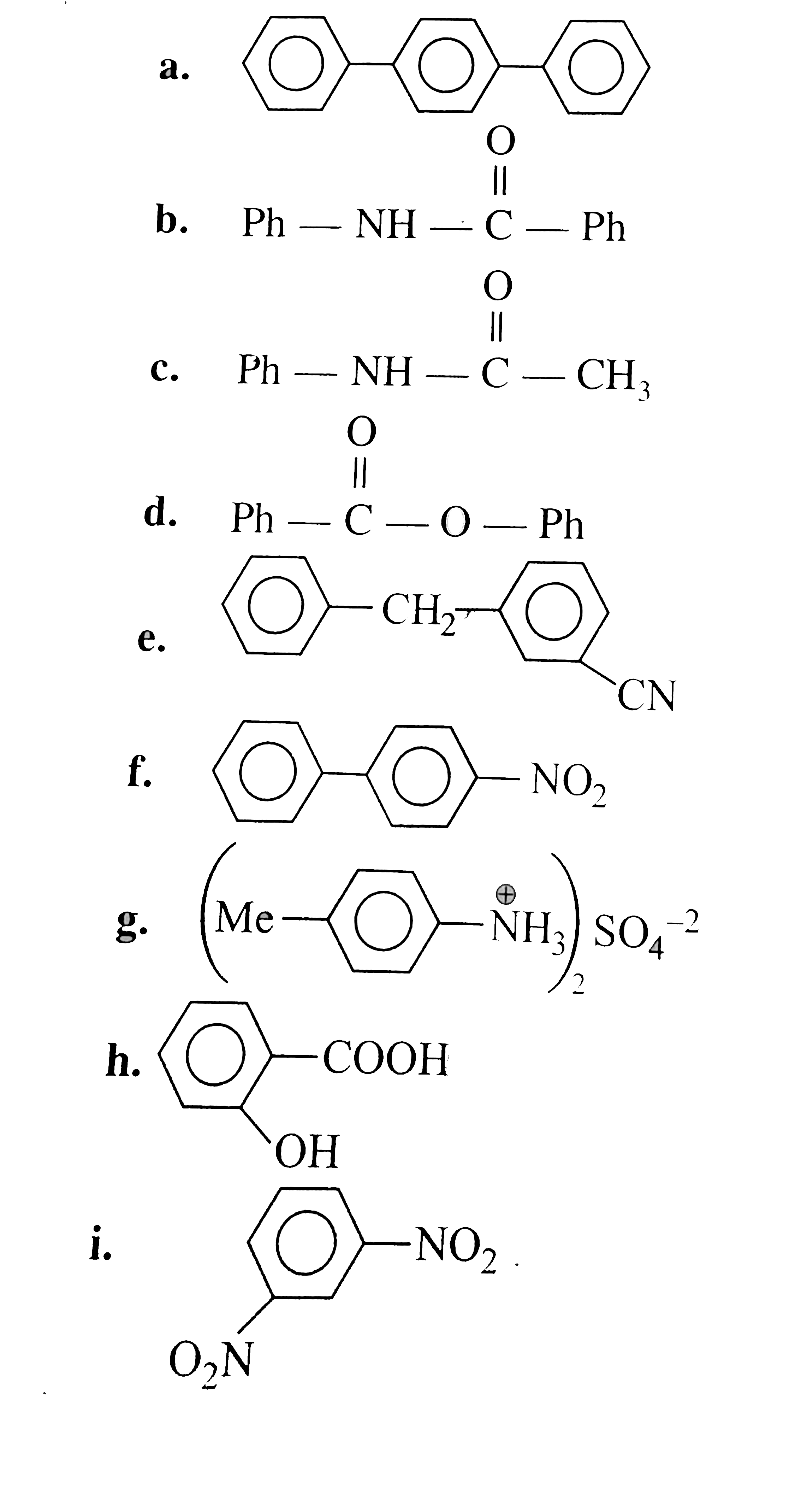
j. `Ph - CF_(3)`
k. `Ph - overset(o+)(N) R_(3) } NO_(3)^(o-)`
l. `o,m-` and `p-` EthoxyacentanilideView SolutionComplete the following reaction:
`underset((A))(o-HOOC) - C_(6) H_(4) - CH_(2) - Ph overset(SOCl_(2))rarr (B)`
`underset(AlCl_(3) , CH_3Cl)overset("Anhyd")(rarr) (C) underset(+HCl)overset(Zn + Hg)(rarr) (D) `02:59View Solutiona. Which of the following shows primary isotope effectgt
i. Nitration of benzene. ii. Halogenation of `CH_(4)`. Iii. Alkene prepared by `E.lcB` mechanism.
b. Which of the following shows secondary isotope effect?
i. An alkene obtained by `E.2` mechanism
ii. An alkene obtained by `E.l` mechanism
c. Which of the following examples of `K_(H)//K_(D)` (ratio of rate constant) is greater than `1`.
i. `PhCH_(2)CH_(2) Br` adn `PhCD_(2)CH_(2)Br` towards de-hydrohalogenation by strong base.
ii. Conservation of:
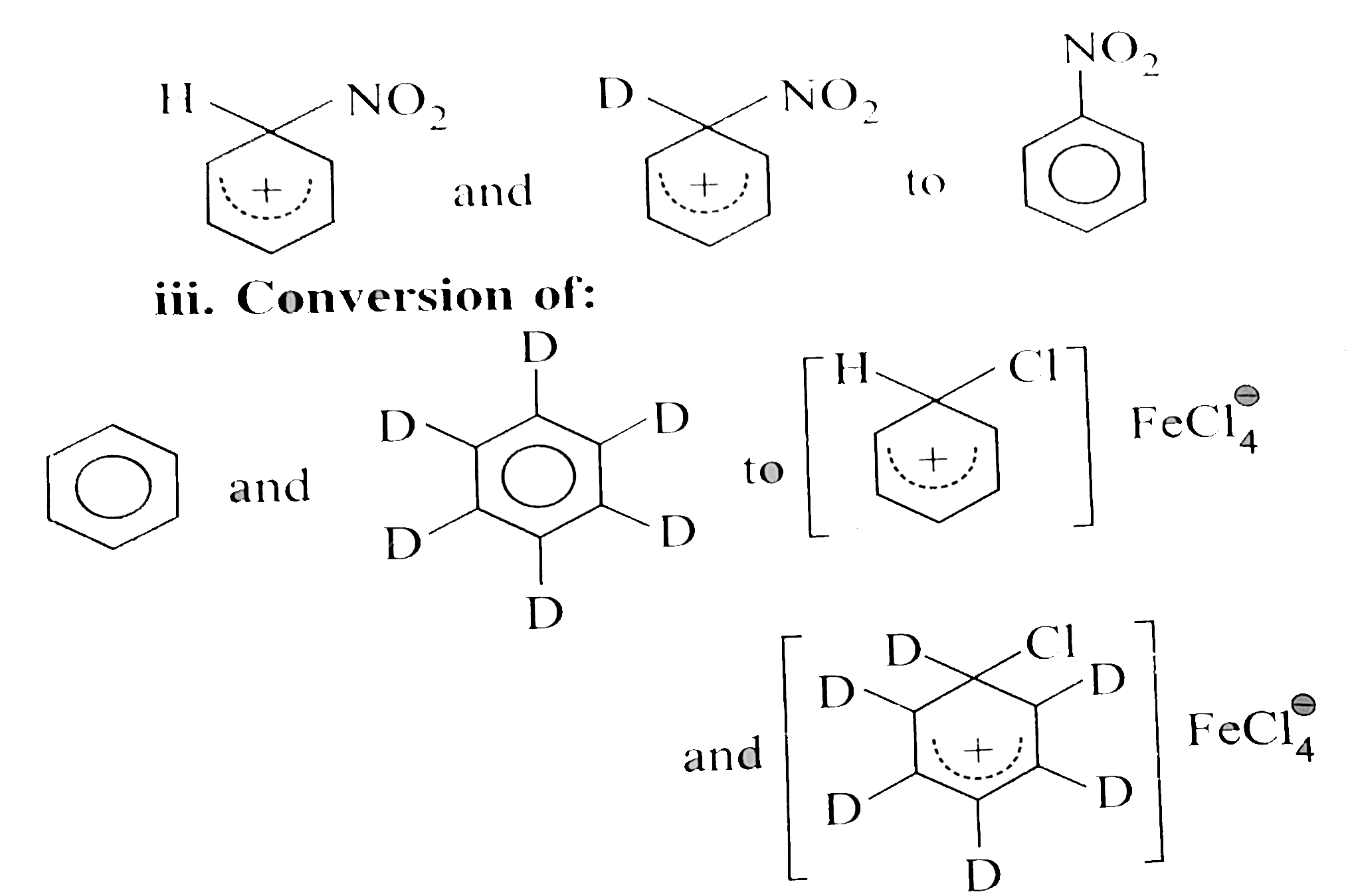
iii. Conservation of:
 View Solution
View SolutionConvert benzene to adjacent trimethyl benzene.
View Solutiona. In the `F.C`. Alkylation with alkene, why is `HF`, not `HBr`, used? How does `HF` at high temperature effect the dealkylation process?
In Illustration `11.24` in the conversion of (I) to (II), why dows alkylation take place at 2 and 6 positions rather than at 3 and 5 positions?
c. Expain which product (I) or (II) is formed and why.
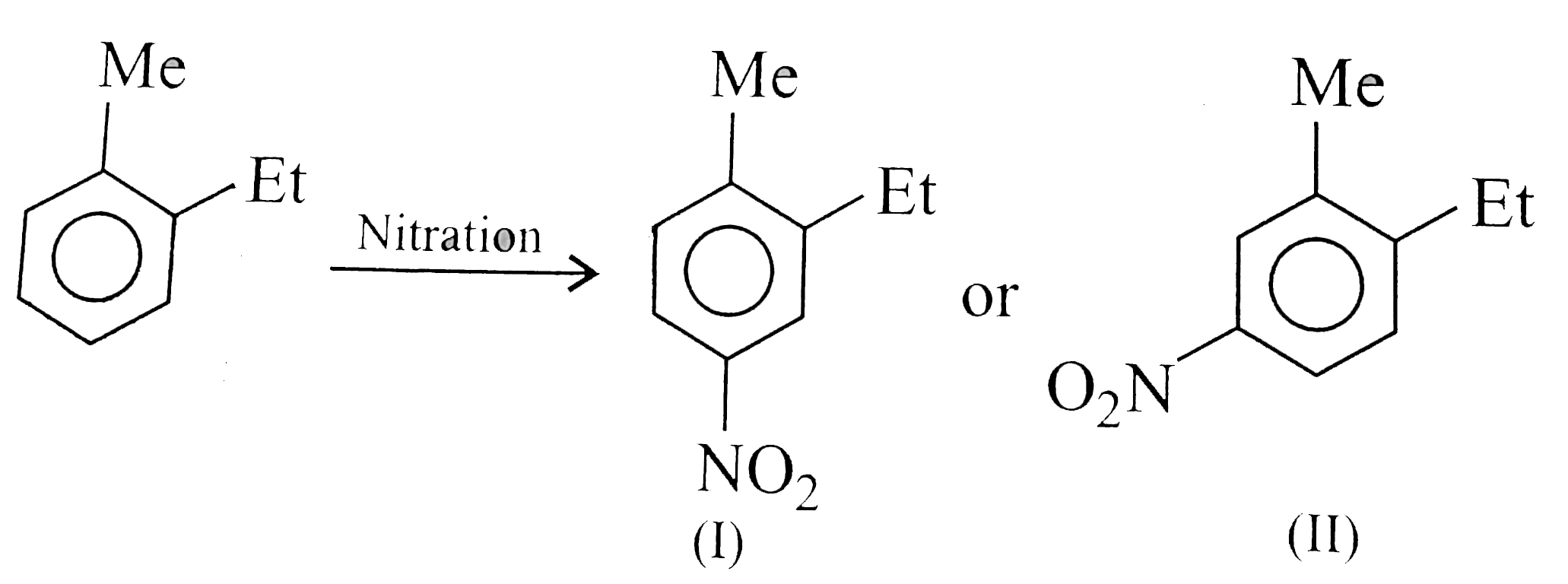
d. What is the depreesion in freezing point of `1m` soultion of nitrating mixture `(K_(f) = x K, kg mol^(-1))`?View SolutionComplete the reaction:
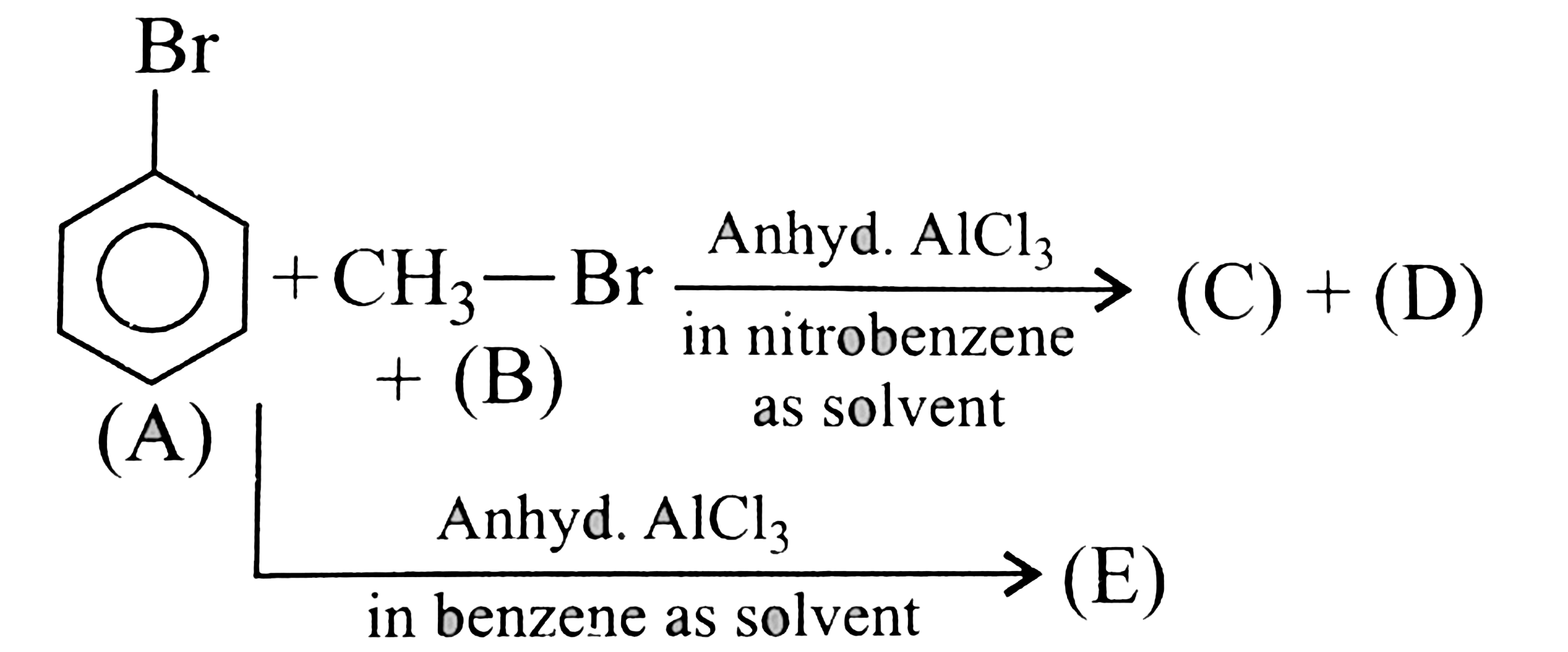 View Solution
View SolutionComplete the following reaction:

 View Solution
View SolutionFor dofferemt reactions of `H_(2)SO_(4)` with (i) `HNO_(3)` and (ii) `HClO_(4)`,
a. Write the equactions for the recactionsand identify the conjugate acids and bases:
b. Expain the different behaviours of `H_(2)SO_(4)`
II. Nitrobenze can be prepared from benzene by using a mixture of conc. `HNO_(3)` and conc. H_(2)SO_(4) In the nitrating mixture, `HNO_(3)` acrs are:
a. Base, b. Acid
c. Reducing agent, d. Catayst
III. Among the following statements on the nitraction of aromatic compounds, the false one is:
a. The rate of nitration of benzene is almost the sameas that of hexadeucterobenzene.
b. The rate of nitration of touene is grater than that of benzene.
c. The rate of nitration of benzene is greater than that of hexadeuterobenze.
c. The rate of nitration of benzene is greater than that of hexadeuterobenezene.
d. Nitration is an electrophillic subsitution reaction.
IV. Select the correct alternatice(s).
The following reaction occurs in a mixture of conc. `HNO_(3)` and cnc. `H_(2)SO_(4)` as:
`HNO_(3) + 2H_(2)SO_(4) rarr NO_(2)^(o+) + 2HSO_(4)^(o+) + H_(3)^(o+)`
Which of the following statements about this reaction is correctgt
a. Nitric acid acts as a base.
b. Sulphuric acid acts as a base.
Sulphure acid acts as a dehydrating agent.
d. Addition of `H_(2)O` will reduce the `NO_(2)^(o+)` concentration.
e. `HNO_(3)` and `NO_(2)^(o+)` are conjugate acid-base pair.View SolutionComplete the following reaction:
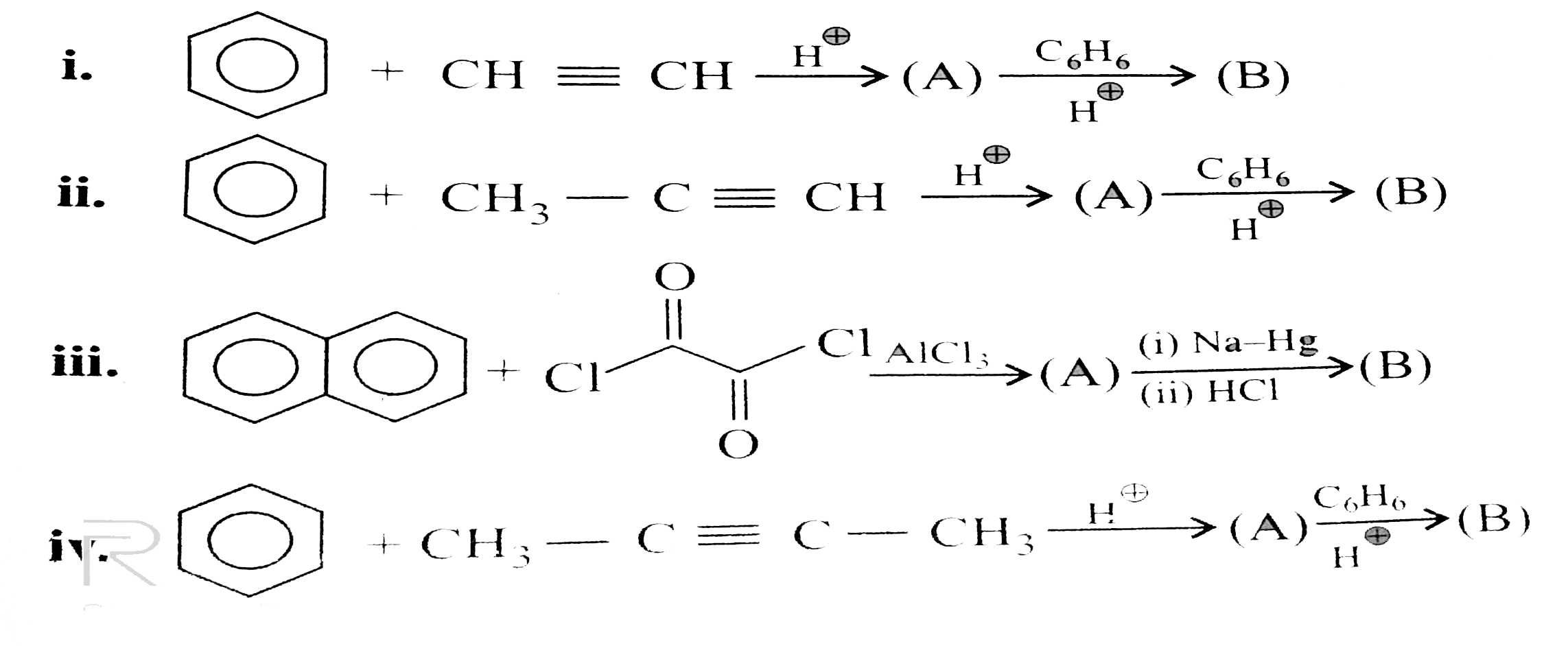
 View Solution
View SolutionComplete the following reactions:

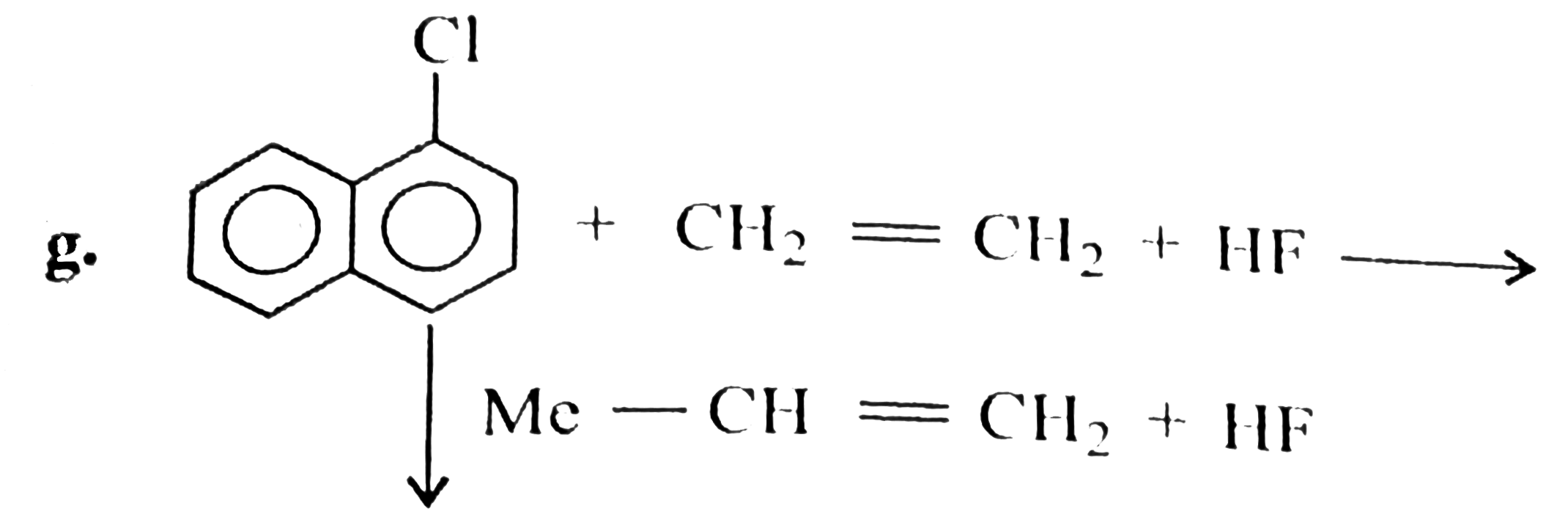 View Solution
View SolutionConvert the following:
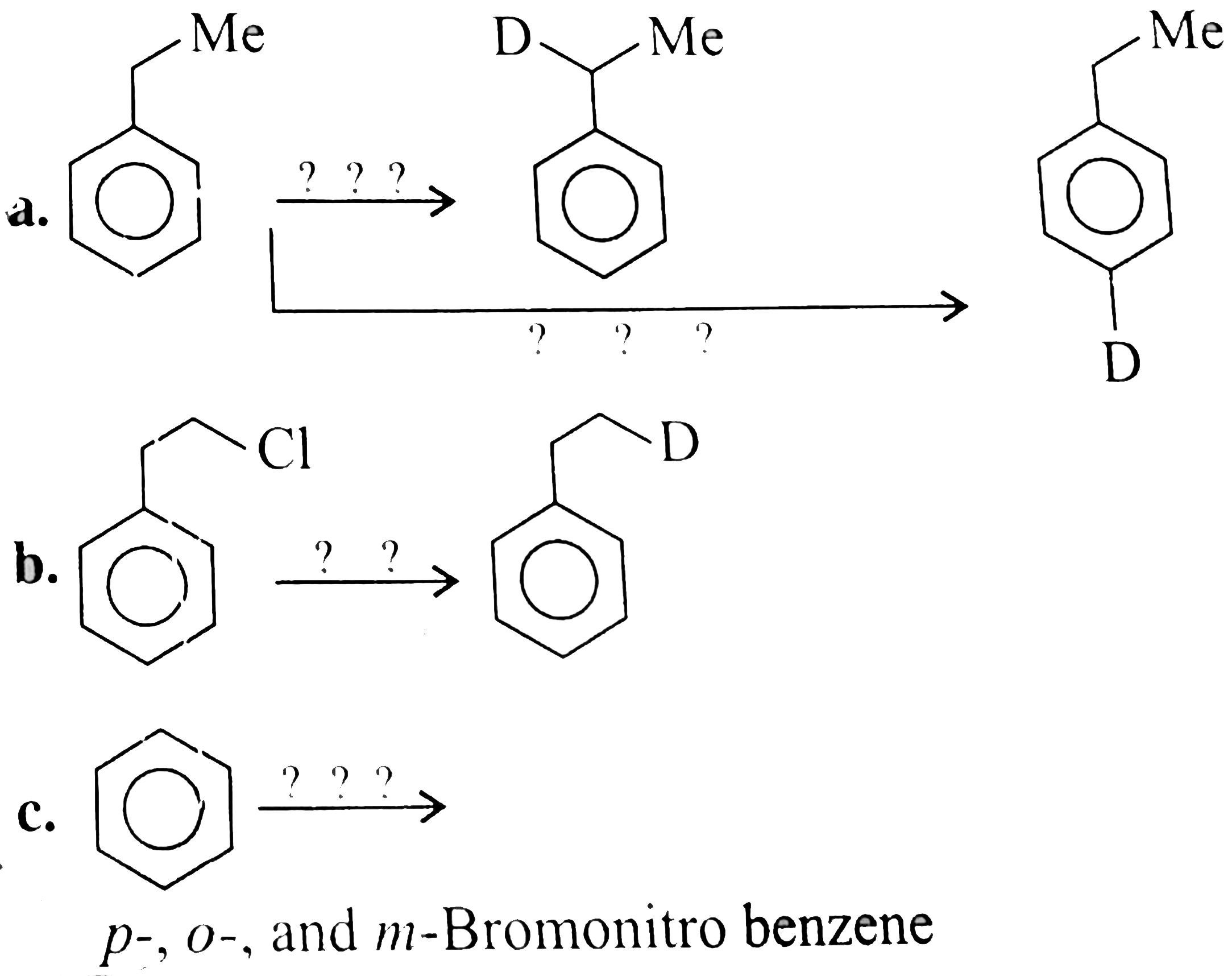
 View Solution
View SolutionAnswer the following species `(I - IV)` according to the decreasing order of potential energy.

b. Which of the following resonance structures is/are wrong?
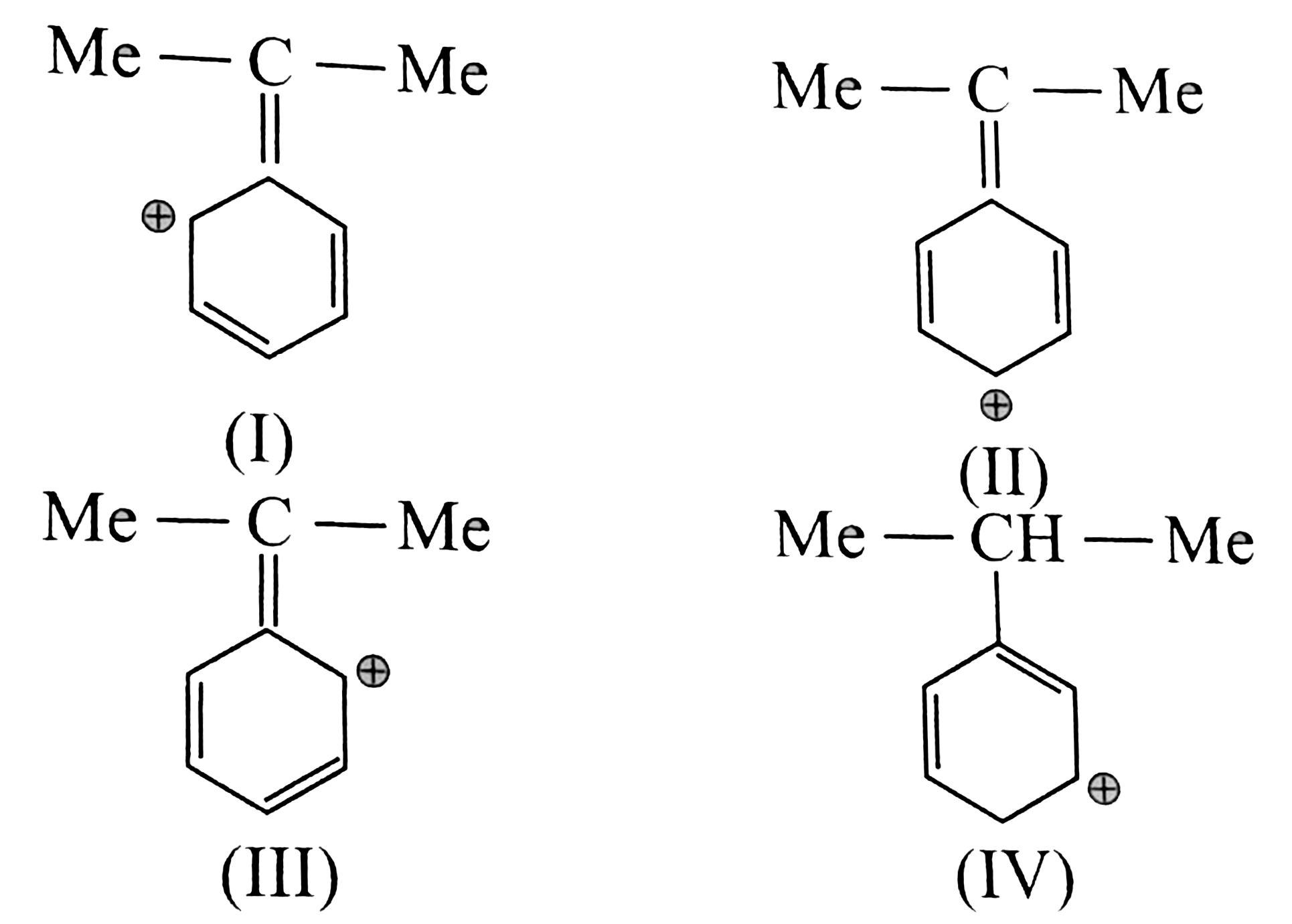
c. Which of the following is/are stable resonating structures?
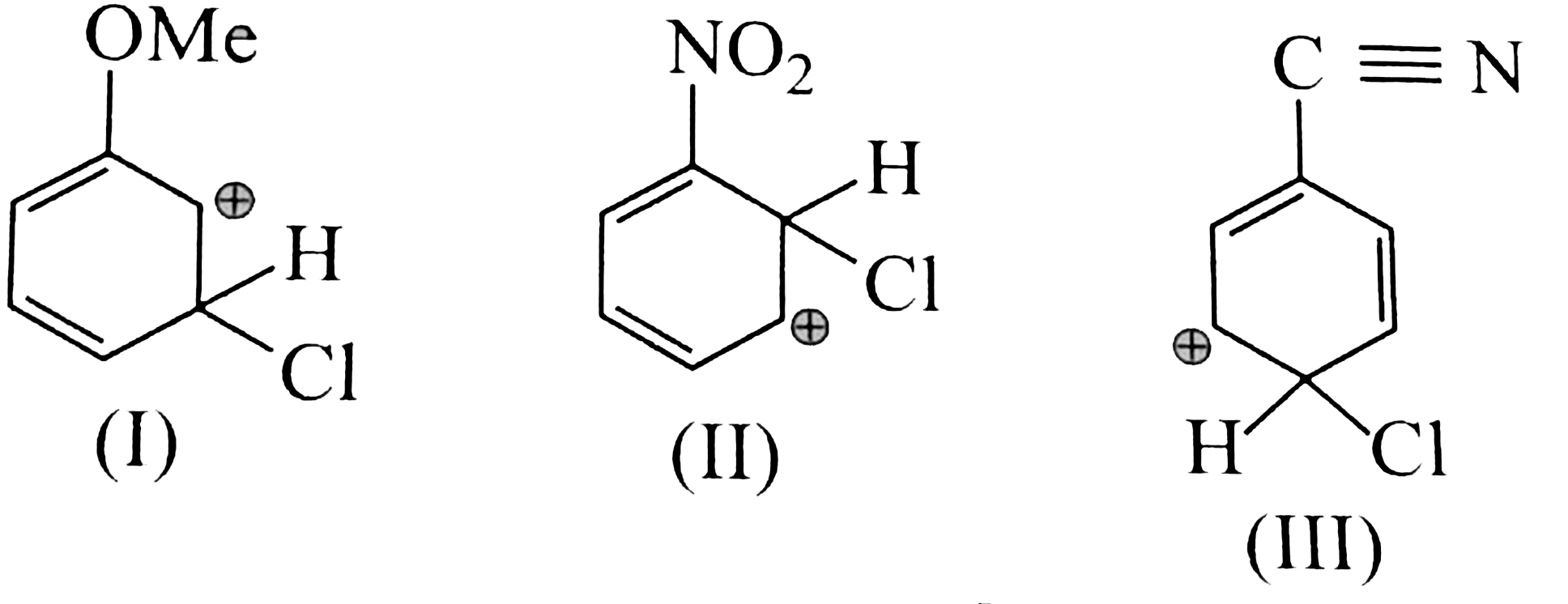
d. Whichof the following is/are least stable arenoinum ion ?
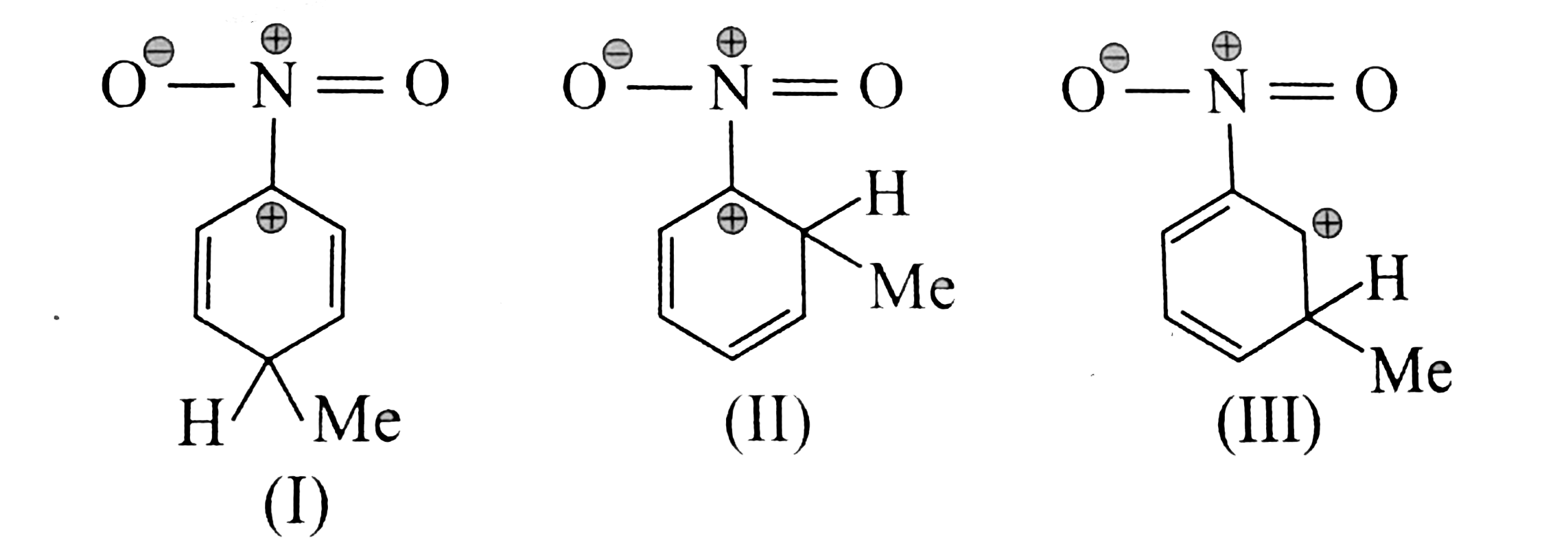 View Solution
View SolutionExpalin the following:.
. The acidic character fo halogen-substituded pehnol is:
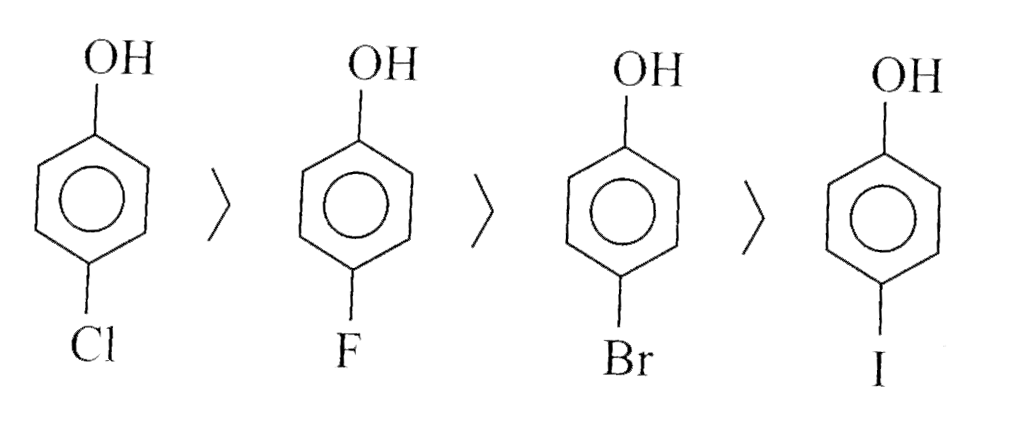 04:16View Solution
04:16View Solution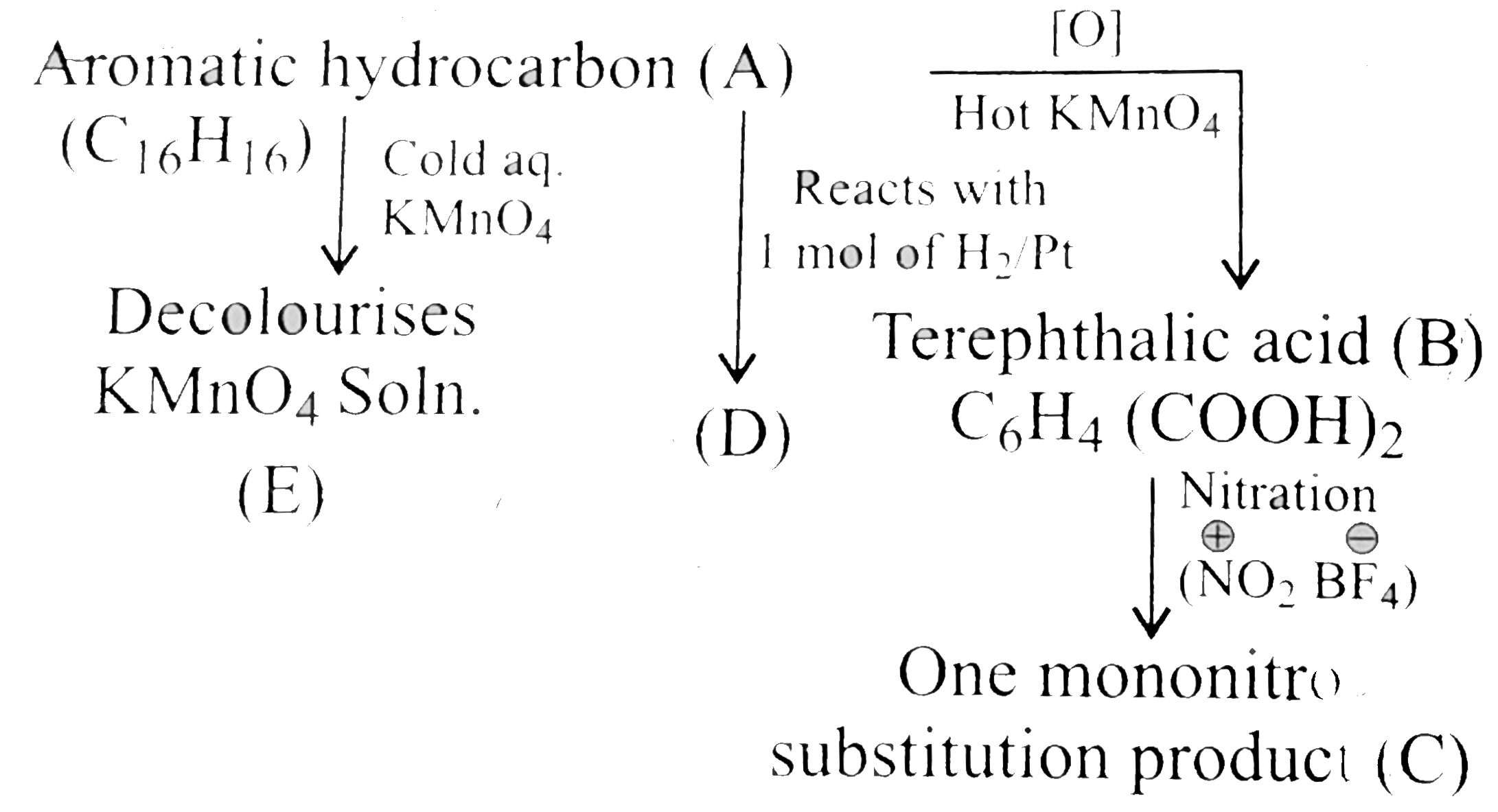
Identify`(A)`to`(E)` .Write the number of possible steroisomers of`(A)`.View SolutionFor reaction(I)
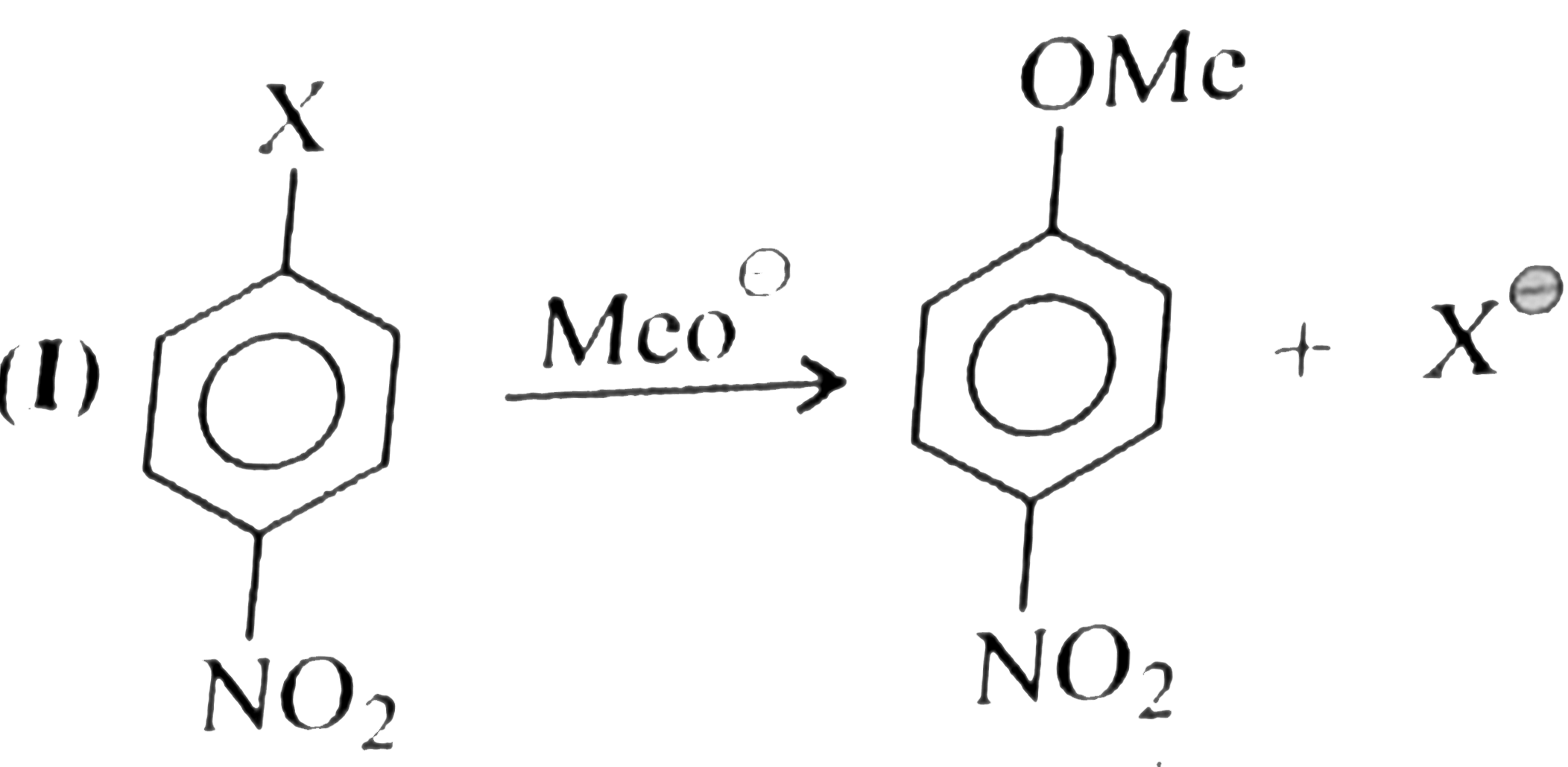 ,why is the order of reactivity of haldies `ArFgt gt ArClgtArBrgtarl`,although`F^(ᶱ)`is a oor leaving group?Explain.View Solution
,why is the order of reactivity of haldies `ArFgt gt ArClgtArBrgtarl`,although`F^(ᶱ)`is a oor leaving group?Explain.View Solution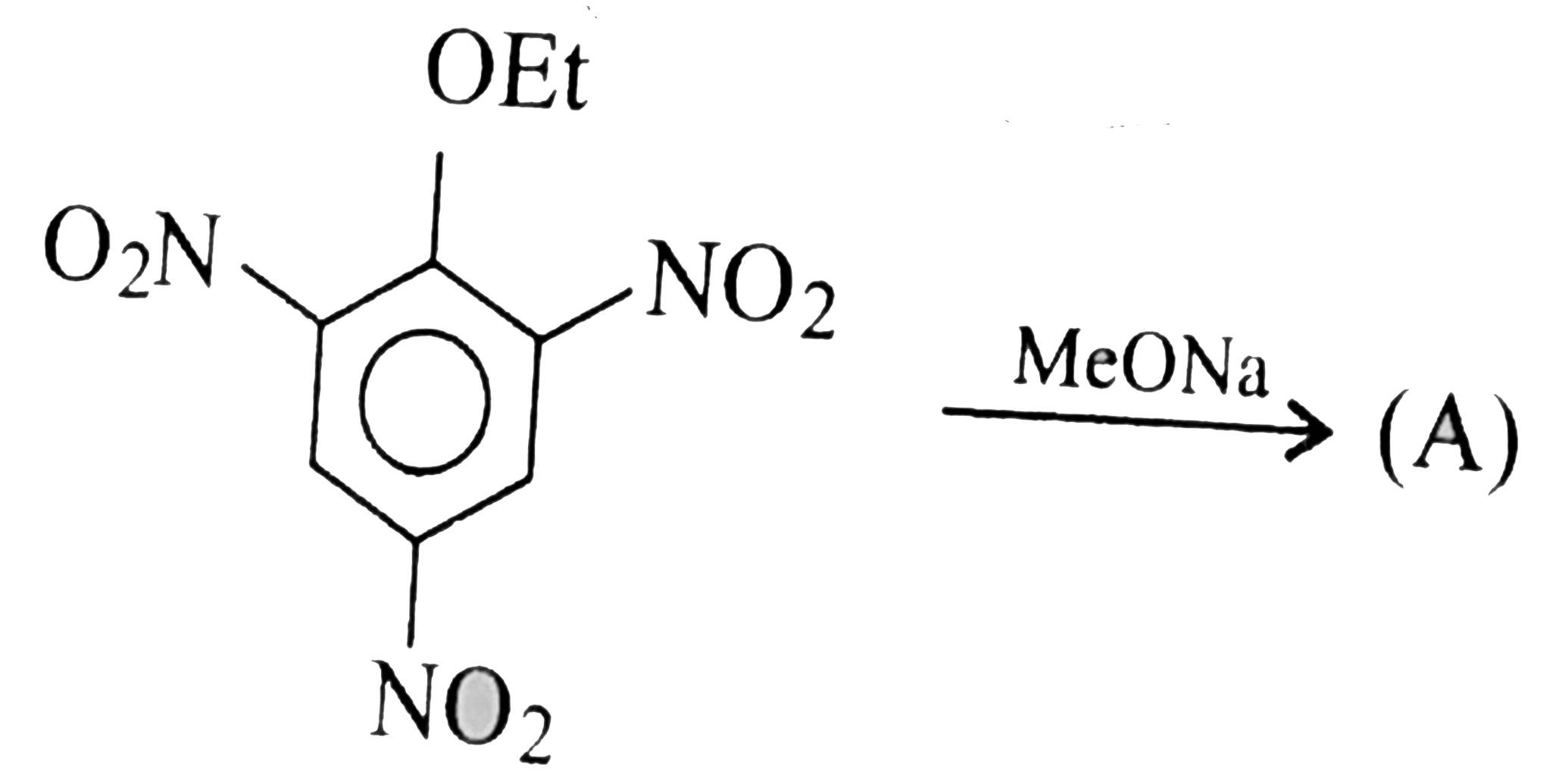
Identify A01:34View SolutionGive the decreasing order of reactivity of the following `ArSN`(addition-elimiantion reaction).
(a) I.
(II)
(b)(III)
(IV) View Solution
View SolutionGive the decreaes order of`ArSN`reaction of the following with`NaOMe`:
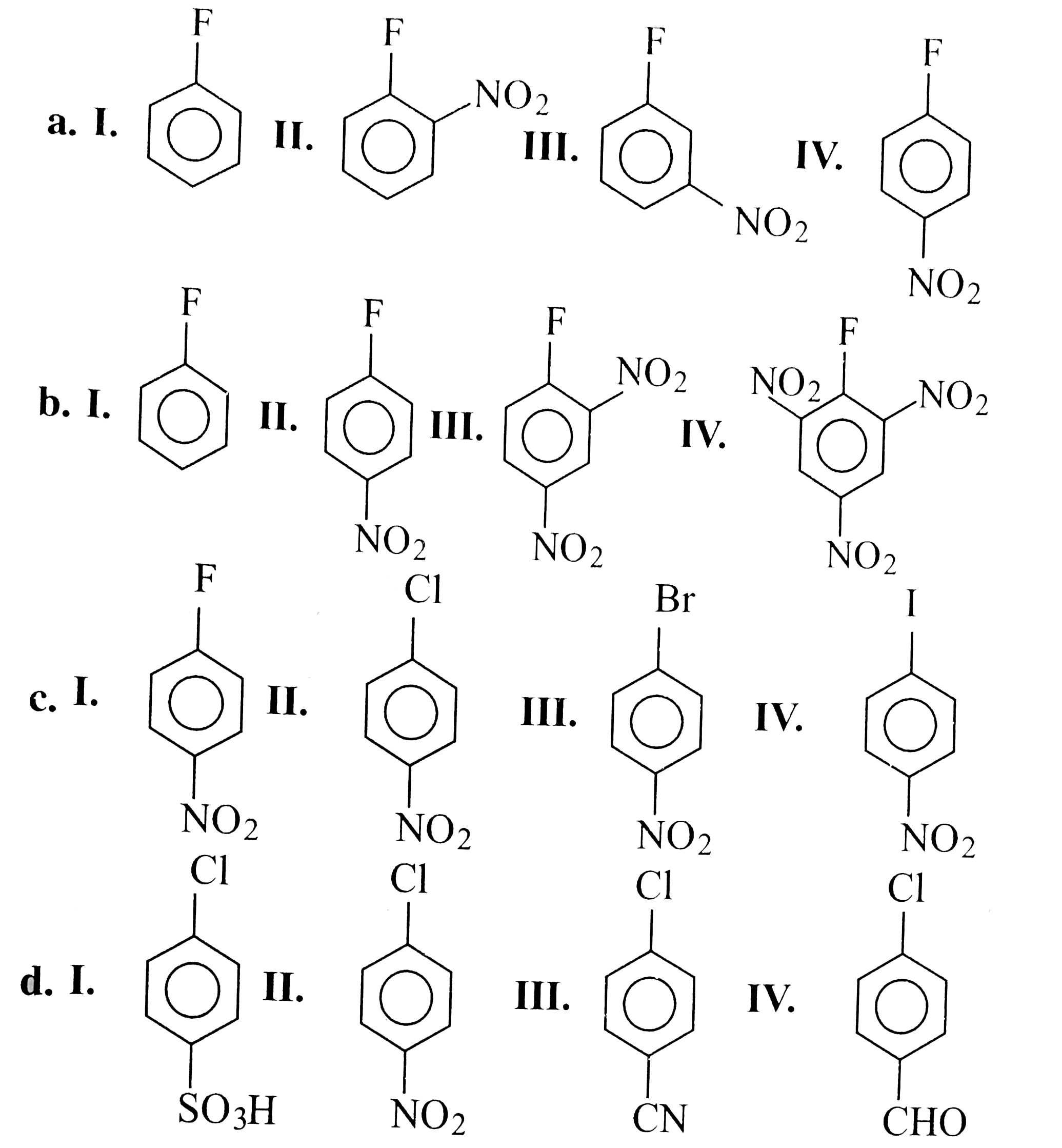 View Solution
View Solution(a)Azulene has an appreciabel dipole moment.Write the reasonance structure that explains the dipole moment and its aromaticity.
(b)In the cse of halogen-substituted azulenes,a halogen atom on`C-6`can be displace bynucleophile while one on`C-1`is unreactive towards nucleophile .Rationalise this differemce in behaviou.View SolutionGive the reaction and explain the formation of the products.
 View Solution
View Solution(a)`Me_(3)CCH_(2)CH(Cl)Ph`., (b)`MeC(Et)_(2)CH_(2)Cl`
(c)`MeCH=C(Br)CH_(2)Me_(2)`,(d)`m-ClC_(6)H_(4)CH_(2)CHMe_(2)`
(e)`p-I-C_(6)H_(4)CH(Me)Et` (f)`p-FCH_(2)C_(6)H_(4)CH_(2)Cme_(3)`
(g)`MeCH=CHC(Cl)Me_(2)`,(h)`MeC(Br)(et)Et`
(i)`MeCH=CHc(Cl)Me_(2)`,(j)`EtC(Me)_(2)CH_(2)Br`
(k)`Me_(2)CHCH(Br)Me` ,(L)`BRCH_(2)C-=CCH_(2)Cl`
(m)`CHF_(2)BrClF` ,(n)(CBr_(3))_(3)CBr)`
(o)`MeC(p-BrC_(6)H_(4))_(2)CH(Cl)Me` ,(p)`Me_(3)CCH=ClC_(6)H_(4)Cl-m`View SolutionWrite the stick,condensed and bond line structure of the following compounds:
a.`4-`tertButyl`-3-`chloroheptane ,b`.2-(2-`Bromophenyl)`-1-`chloro octane
c m-Bromochlorobenzene d Perchlorobenzene
e.`1-`Bromo`-4-`ethyl cycohexane .f`2`-Fluoro`-3-`methyl pentane
`1`-Chloro`-4`sec butyl`-2`methyl benzene ,`1,4-`Dichloro but`-2`ene
i`4-`tert-Butyl`-3-`fluoro heptane ,j`1`iodo`-4-`ethyl cyclohexane
k`2-`Fluoro`-3-`methyl pentaneView SolutionWrite IUPAC name of the following with(cis or trans)or(EandZ)if any.
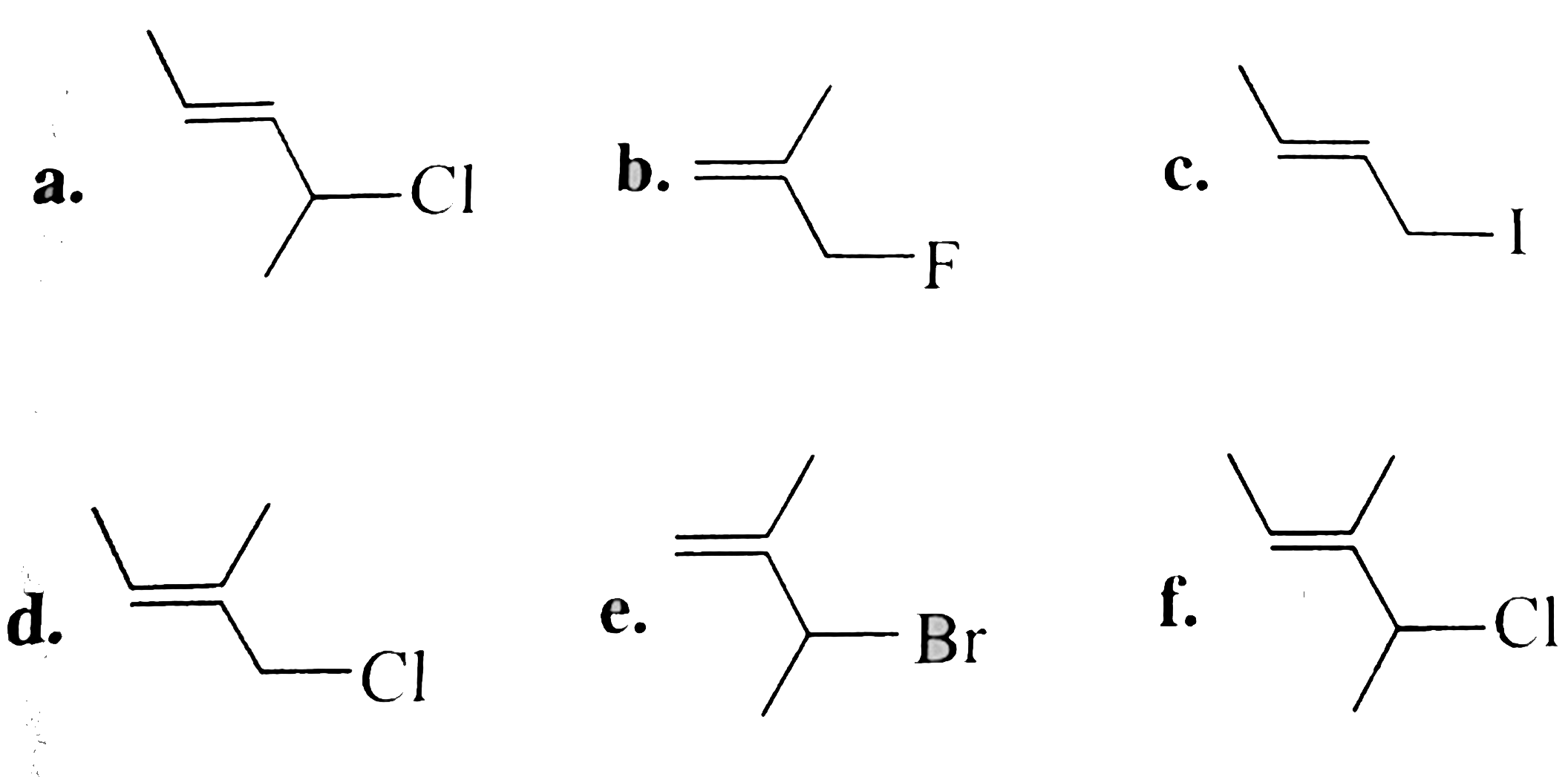 View Solution
View SolutionArrange the following compounds in decreasing order of dipole moment values Explain the order
(a) `CBr_(4)` , (b) `CHBr_(3)` , (c ) `CH_(2)Br_(2)` , (d) `CH_(3)Br` .05:51View Solutiona. Assign orientation to the three chlorotounes with `mu = 1.3, 1.78`, and `1.9D`.
b. Assign orientation to the three chloronitrobenzens with `mu = 2.5,3.1`, and `4.3D`
c. Which has higher `mu : (1)
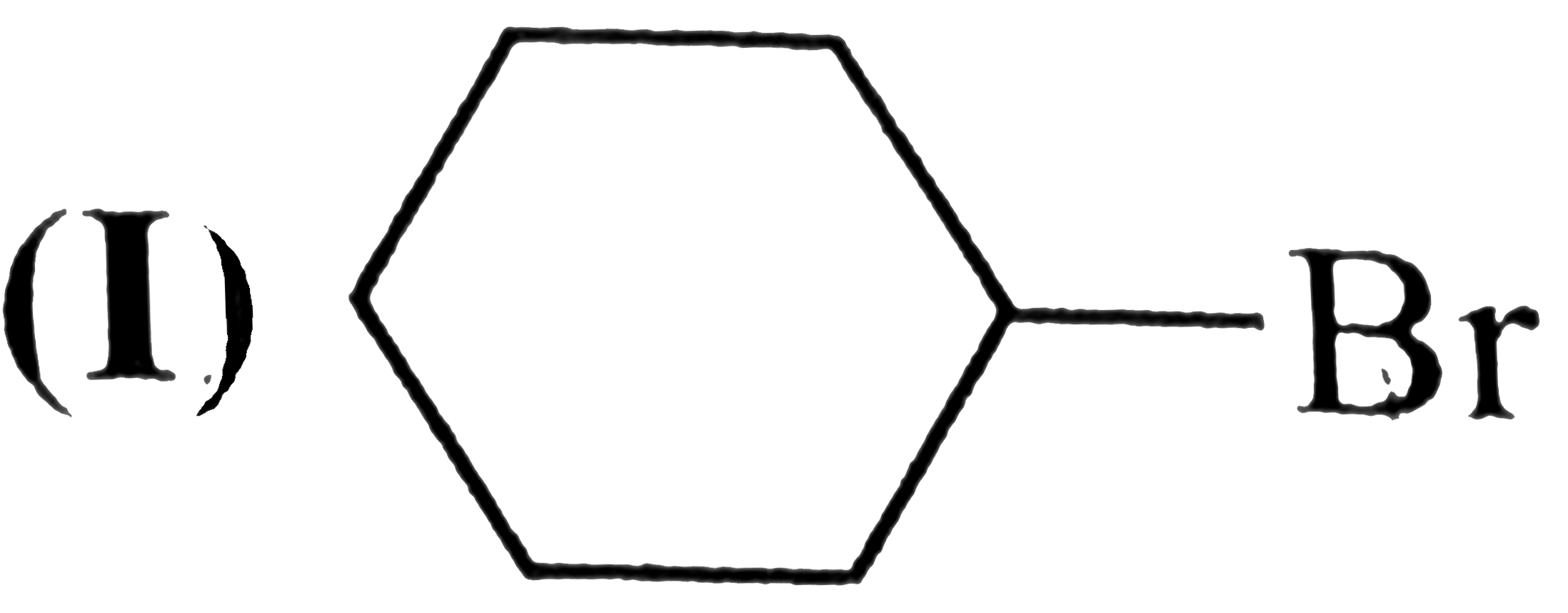 or II. `PhBr`?View Solution
or II. `PhBr`?View SolutionWhat are the numerical values of `(M)` and `(N)` in the following reaction ?
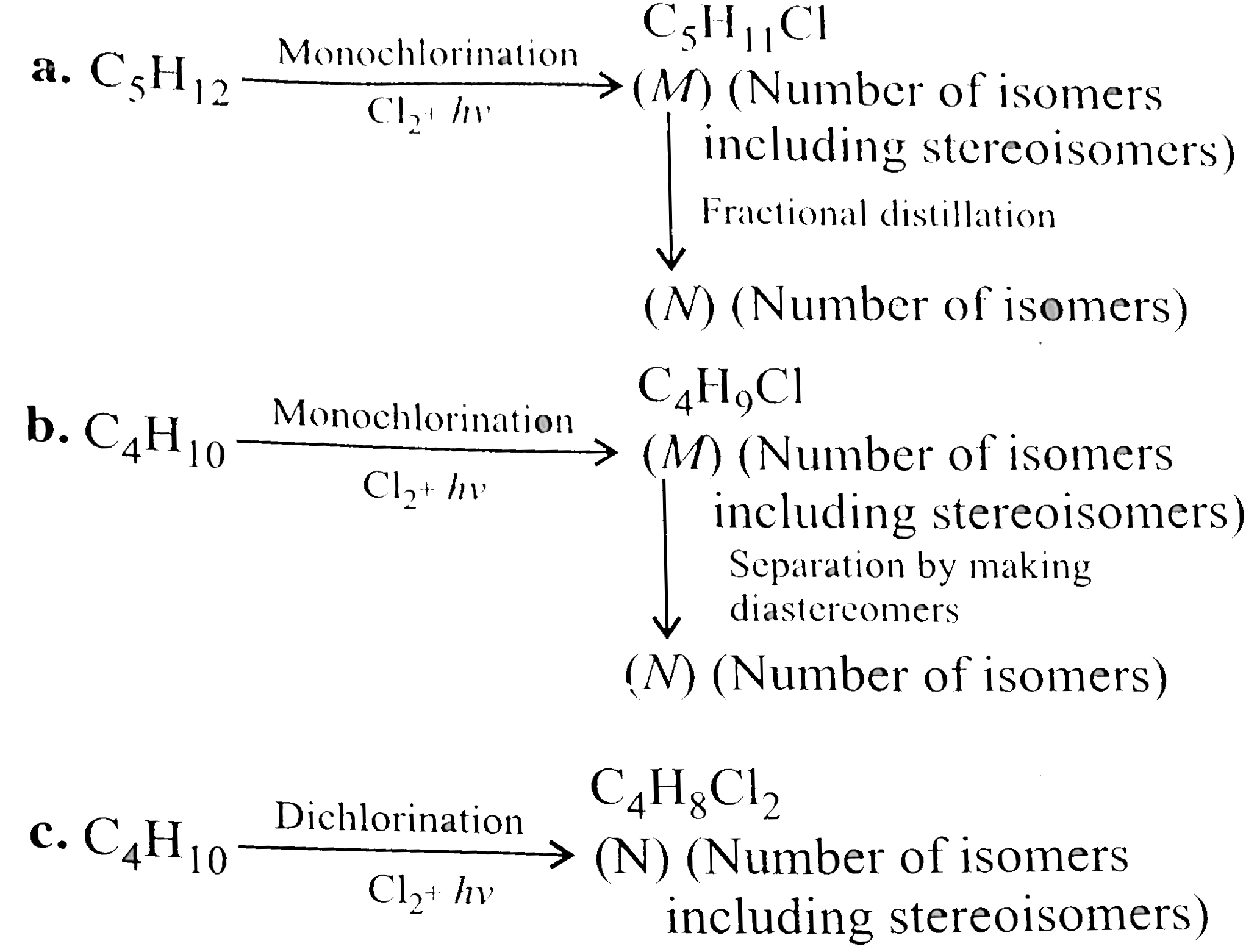 View Solution
View Solutiona. Prepare the following ethers via Willamson's syntesis.
I. Benzyl methyl ether `(A)`
II. Phenylethyl ehter `(B)`02:15View Solutiona. An armatic compound `(A) (C_(7)H_(8) O)` on reaction with `Br_(2) + H_(2)O` gives a white ppt. of compound `(B) (C_(7) H_(5) Obr_(3))`. Compound `(C)`, an isomer of `(A)` also gives the same reaction and gives a white ppt. of compound `(D) (C_(7) H_(5) OBr_(3))`. Compound `(C)` is insoluble in `NaOH`. identify `(A), (B), (C)` and `(D)`.
b. I. Starting from `C_(6) H_(6)` and `C_(6) H_(5) OH`, synthesise phenyl `1-2,4-` dinitrophenyl ether `(B)`.
II. Could we have first prepared and then nitrated `Ph_(2)O` ?
c. `4-` Chlorobutanol `overset(ᶱ)overset(OH)(rarr) (A) rarr (B) + Cl`
d. `HOCH_(2)- CH_(2) - CH_(2)OH underset(160-170^(@)C)overset("Conc". H_(2) SO_(4))(rarr)`View SolutionIndentify `(A)` to `(E)`.
a. `1,3-` Butadience `+ BrCCl_(3) + "Preoxide" rarr (A)`
b. `RCH = CH_(2) + CCl_(4) overset("Peroxide")(rarr) (B) + (C)`
c. `1-` Octene `+ CHCl_(3) overset("Peroxide")(rarr) (D)`
`1-` Octene `+ CbrCl_(3) overset("Peroxide")(rarr) (E)`View Solutiona.Complete the following:
b.
Identify all the possible products. Give the major product and racnk the products in decreasing order of reactivity with `NBS`.
c.
Indentify all the possible products. Give teh major products and list them in decreasing order of reactivity with `Me_(3) CoCl`.View Solutiona.Explain the following
a. Dipole moment of `CH_(3)F` is `1.85D` and that of `CD_()F` is `1.86D`.
b. `8-` Hydroxy quinoline can be separarted from `4-` hydroxy quinoline by steam disillation:
c. The boiling point of `(C_(2) H_(5))S gt (C_(2) H_(5))_(2)O`.
d. The `pK_(a)` of `o-` fluorobenzoic acid `(I)` is `4.14`, wheraes that of `p-` chlorobenzic acid `(II)` is `3.99`.
e. Glycine exists as zwitterion , but `PABA` does not.
f. Write teh structure of carbocation produced on treatment of a compound `(A) (Ph_(2) CHC(OH) Me_(2))` with `SbF_(5)//SO_(2)`.View Solutiona. The dipole moment of `HBr` is `2.6xx10^(-30) C.m` and intertomic spacing is `1.41 Å`. What is the percent ionic character of `HBr` ?
b. A diatomic molecule has `mu = 1.2D`. Its bond distance is `1.0 Å`. What fraction of electronic charge exists on each atom ?
c. In water, `(H-O-H)` bond angle is `105^(@)`. The distance between `(O-H)` is `0.94 Å. mu` of `H_(2)O = 1.85D`. Determine the magnitude of the charge on the oxygen atom in water molecule and hydrogen atom.
d. `Bl_(3)` is a symmetrical planner molecule, all the `(B-1)` bonds lie at `120^(@)` of each other. The distance between the `I` atoms is `3.54 Å`. THe Estimate the covalent radius of boron. e. Calculate the dipole moment of the following compound:
 View Solution
View SolutionComplter the following:

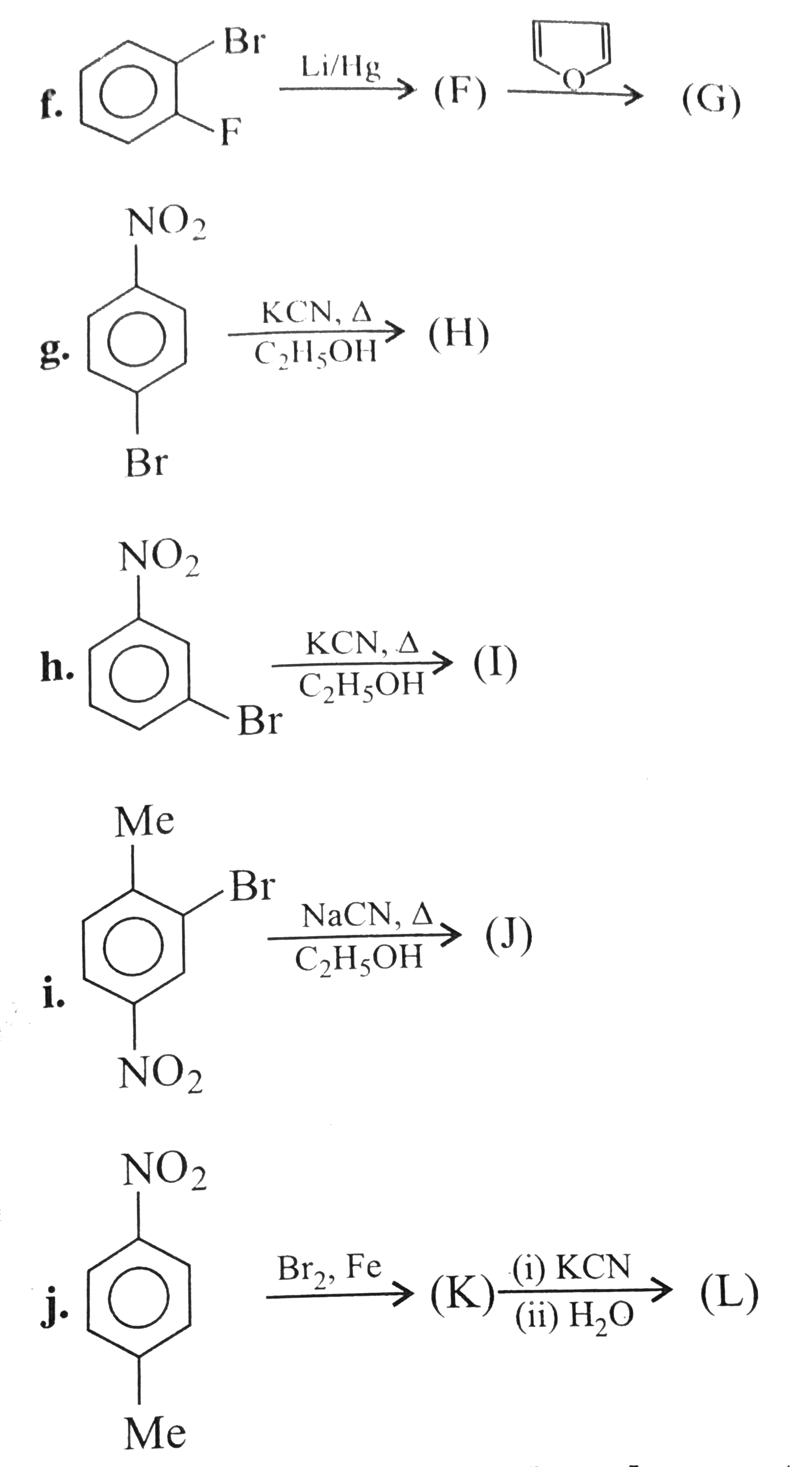
II. Which of the folliwng has the greater `K_(a)` value?
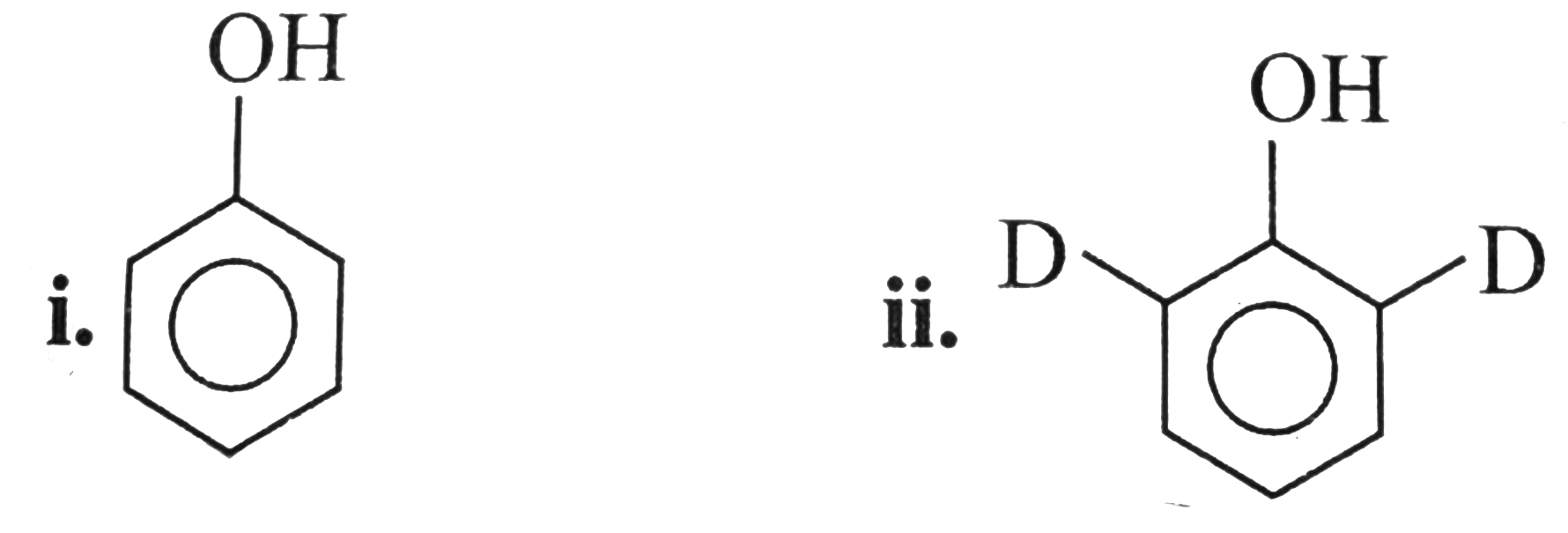
III. Which of the carbonyl groups in `(a)` and `(b)` protonate more readialy in acid solution and why ?
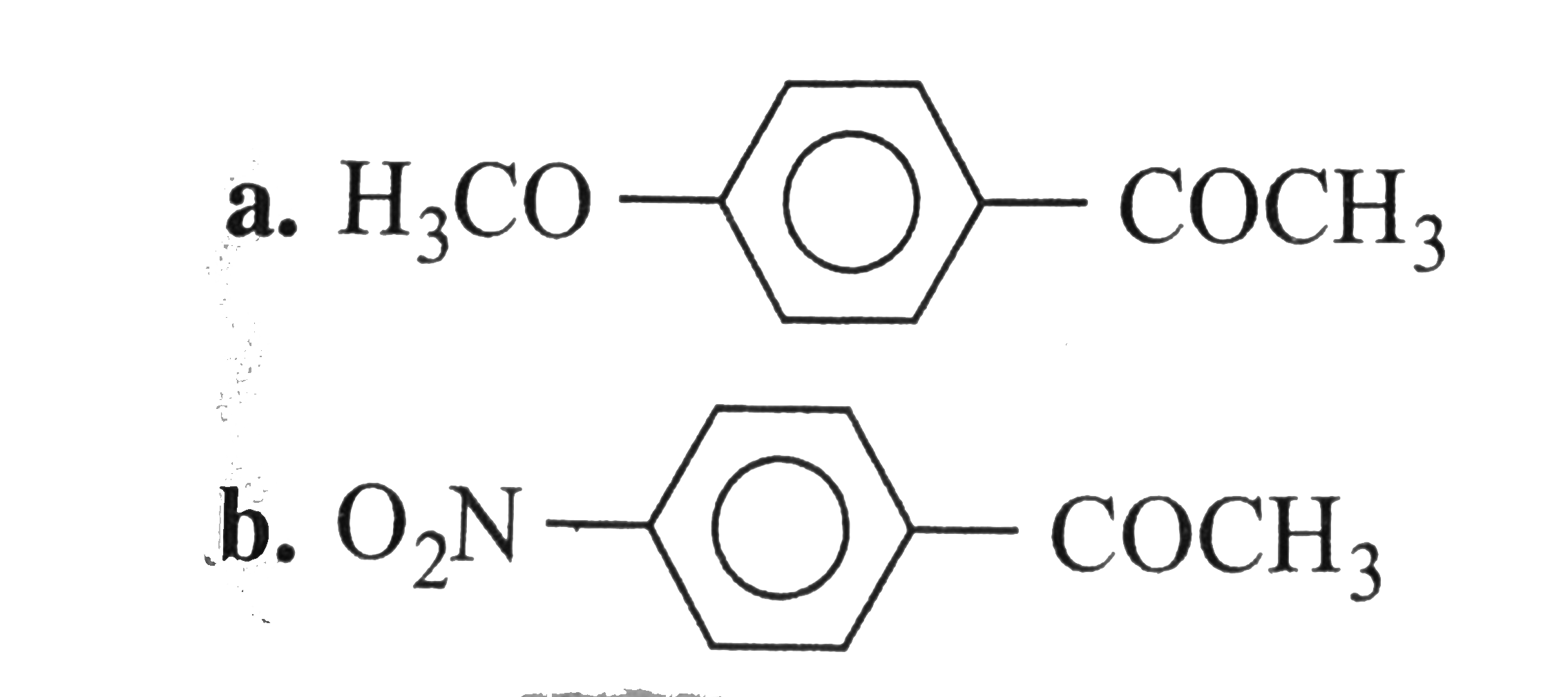
IV. When a trace of `KNH_(2)` is added to a solution of chlorobenzene and potassium triphenyl mehide `(Ph_(3) C^(ᶱ) K^(o+))` in liquid `NH_(3)`, a rapid reaction takes place to yield a product of formula `C_(25) H_(20)`. What is the product? What is the role of `KNH_(2))` and why is it needed?View Solutiona. Indicate whether the following are `SN^(-1), SN^(-1), E1`, or `E2`
1. `(CH_(3))_(3) CBr + C_(2) H_(5) OH` at `60^(@) rarr underset(("Major"))((CH_(3))_(3)C ) - OC_(2) H_(5) + underset(("Minor"))((CH_(3))C) = CH_(2)`
2. `CH_(3) CH_(2) CH_(2) Br + LiAlH_(4) rarr`
3. `CH_(3) CH_(2) Br + Cl + I^(ᶱ) rarr`
4. `(CH_(3))_(3) CBr + CN^(ᶱ) ("Etanol") rarr`
5. `CH_(3) CHBr - CH_(3) + overset(ᶱ)(O)H (H_(2)O) rarr`
6. `CH_(3) CHBr rarr CH_(3) + overset(ᶱ)(O)H ("Ethanol") rarr`
7. `(CH_(3))_(3) CBr + H_(2)O rarr`
b. Give teh decreasing order of reactivity of the alkaline hydrolysis of the following alkyl halides towards (1) `SN^(-1)` (2) `SN^(2)` and (3) in the presence of `AgNO_(3)`:
i. `(CH_(3))_(2) C (Br) - C_(2) H_(5)` ii. `C_(5) H_(11) Br`.
iii. `C_(2) H_(5) CH (Br) C_(2) H_(5)`.
c.
d. Give teh decreasing order of reactivity of alkaline hydrolysis of the followong halides towards `SN^(-1)`:
1. `MeCl`, ii. `PhCH_(2)Cl`, iii. `Oh_(2)CHCl`, iv. `Ph_(3)CCl`
2.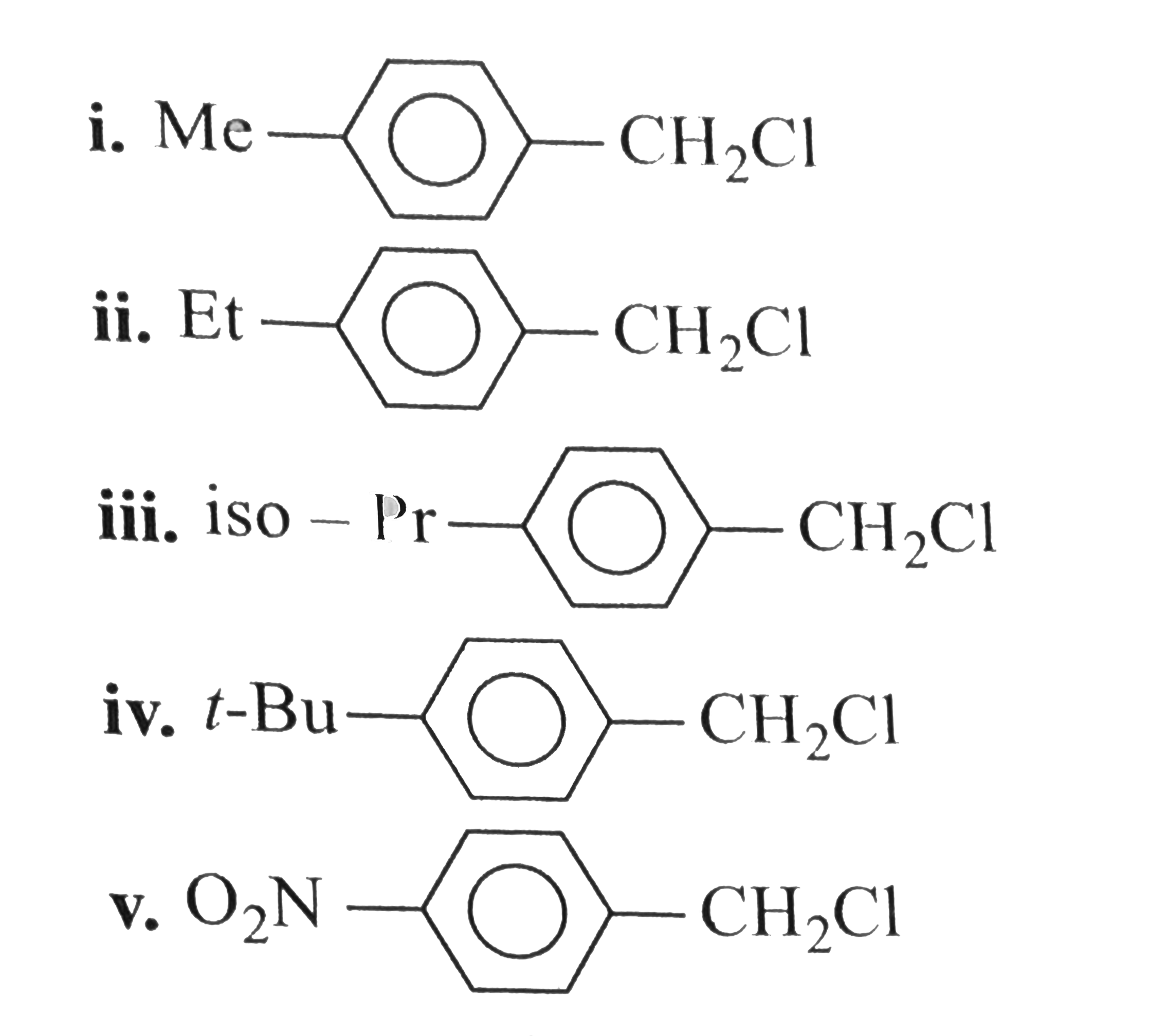
e. Determine the relative `SN^(-2)` reactivity with `NaCN` in aprotic `DMSO` of the following alkyl halides:
1. i. `CH_(3)CHClCH_(2)CH_(3)`
ii. `CH_(3) CHBrCH_(2) CH_(3)`
iii. `CH_(3) CHl CH_(2) CH_(3)`
2. iv. `CH_(3) CH (CH_(3)) CH_(2) CH_(2)I`
v. `CH_(3)CH (CH_(3)) CHICH_(3)`
vi. `CH_(3) CI (CH_(3)) CH_(2) CH_(3)`.
3. vii. `4-` Bromo `1,1-` dimethylcyclohexane
viii. `1-` Bromo -cis or trans`-1,4-` dimethycyclohexane
ix. cis or trans `-2-` Bromo-cis`-1,3-` Dimethyl-cyclohexane
f. Optically pure `(+)-2-` bromoctane, `[alpha] = +36^(@)` reacts with aq. `NaOH` in actone to give opstically pure `(-)-2-` octonal, `[alpha] = -10.3^(@)`. With partically racemised bromo compound whose `[alpha] = +30^(@)`, the `[alpha]` of alchold product is `-6.0^(@)`. Cacualte:
1. The percentage optical purity of partically racemised bromo compound and alchocol,
2. the percentaage of inversion and racemission, and
3. the percentaage of frontside and backside attack.
g. Compare teh rates of `SN^(-1)` and `SN^(-2)` reactions of:
1. Cycloprophyl and cyclopentyl chloride
2. Vinyl chloride
h. Arrange the following in the order of decresing basically:
1. `F^(ᶱ)`, 2. overset(ᶱ)(O)H` 3. overset(ᶱ)(N)H_(2)`, 4. `C overset(ᶱ)(H_(3))`
a. `4gt3gt2gt1`, b. `1gt2gt3gt4`,
c. `2gt1gt3gt4`, d. `3gt2gt1gt4`
i. Arrange the following in the order of decresing nuclepphillic character:
1. `H_(2)O`, 2. `overset(ᶱ)(O)H`, 3. `CH_(3) O^(ᶱ)`, 4. `CH_(3) COO^(ᶱ)`
i. `2gt3gt4gt1`, ii. `3gt2gt1gt4`
iii. `1gt4gt2gt3`, iv. `4gt1gt2gt3`
j. Arrange the following in teh decreasing order as a leaving griup in substitution reaction.
1. CH_(3) CO overset(ᶱ)` , 2. `C_(6) H_(5)O^(ᶱ)`
`C_(6)H_(5) SO_(3)^(ᶱ)`, 4. `CH_(3)O^(ᶱ)`.
a. `3gt1gt4gt2`, b. `3gt1gt2gt4`
c. `3gt2gt1gt4`, d. `4gt2gt1gt3`
k. The order of leaving grou ability for the following is:
1. `-OAc`, 2. `-OMe`
3. `-OSO_(2)Me`, b. 4. `-OSO_(2) CF_(3)`
a. `1gt2gt3gt4`, b. `4gt3gt1gt2`
c. `3gt2gt1gt4`, d. `2gt3gt4gt1`View SolutionExplain why solvolysis (where the solvent is nucleophillic) appears to follow a first-order rater law, rather than a secound order.
II. Complete the following:

III. Predict the product of each `SN^(2)` reaciton Insicate sterochemistry where apporopriate.

IVgt Why is `PhO^(ᶱ)` a weaker nucleophile than `RO^(ᶱ)` ?View SolutionI. `5-` Chloro`-1.3-` cylopentadience undergoes `SN^(-1)` solbolysis in the persence of `Ag'` ion slowly, even though chlorine is doubly allylic, and allylic halides normally ionise reasily. Expalin.
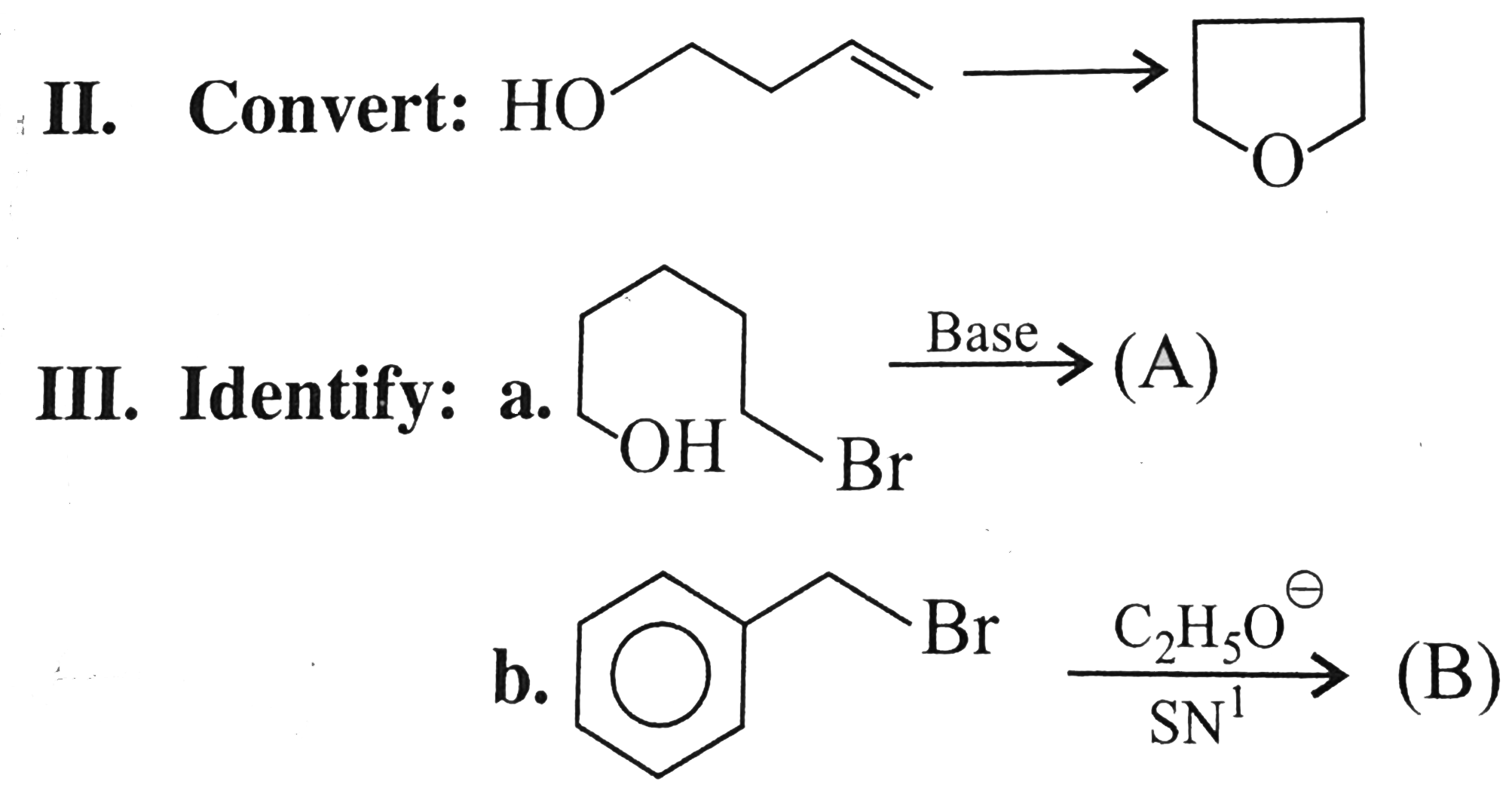
IV. `1-` Choloro `-2-` (dimethylamino) propane `(A)` after standing for several weeks in a sealed contaniner changes to `2-` chloro `-1-` (dimethylamino) propane `(B)`. Explain.
V. Give the major major products of the following elimination reactions:
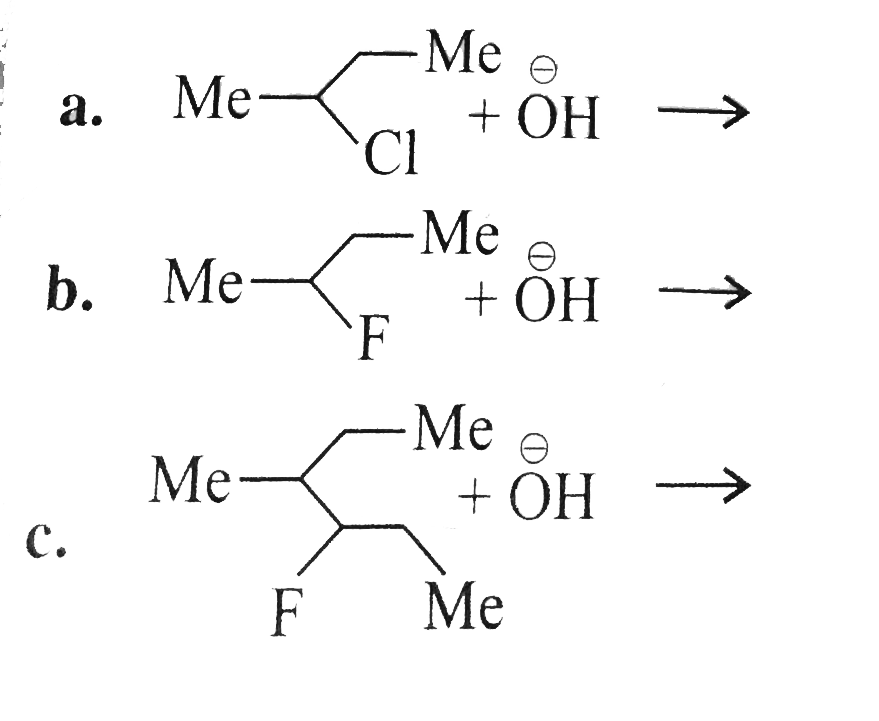
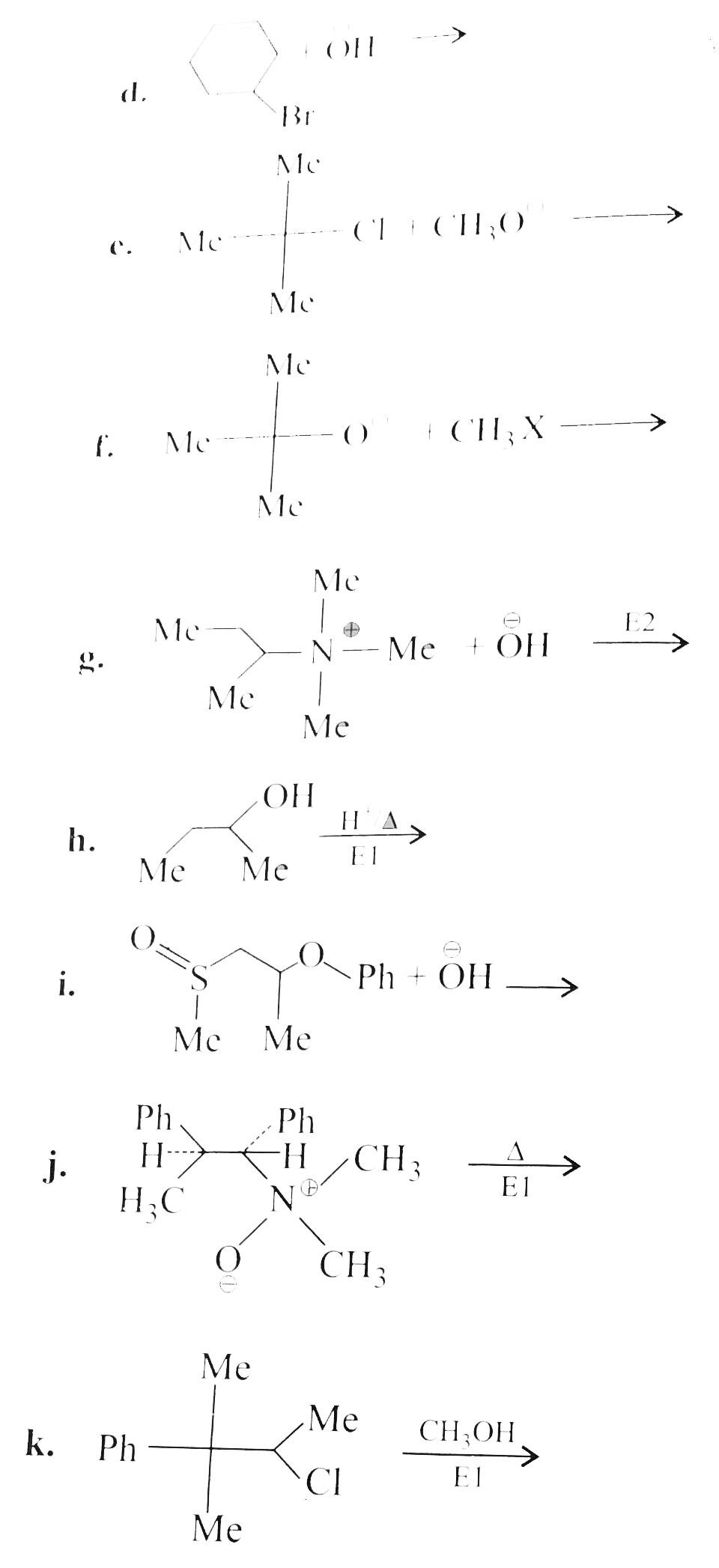 View Solution
View SolutionI. Which of the following will solvolyse faster is `SN^(-1)` and why?

II. `F^(ᶱ)` works as a good leaving group in `ArSN` reaction
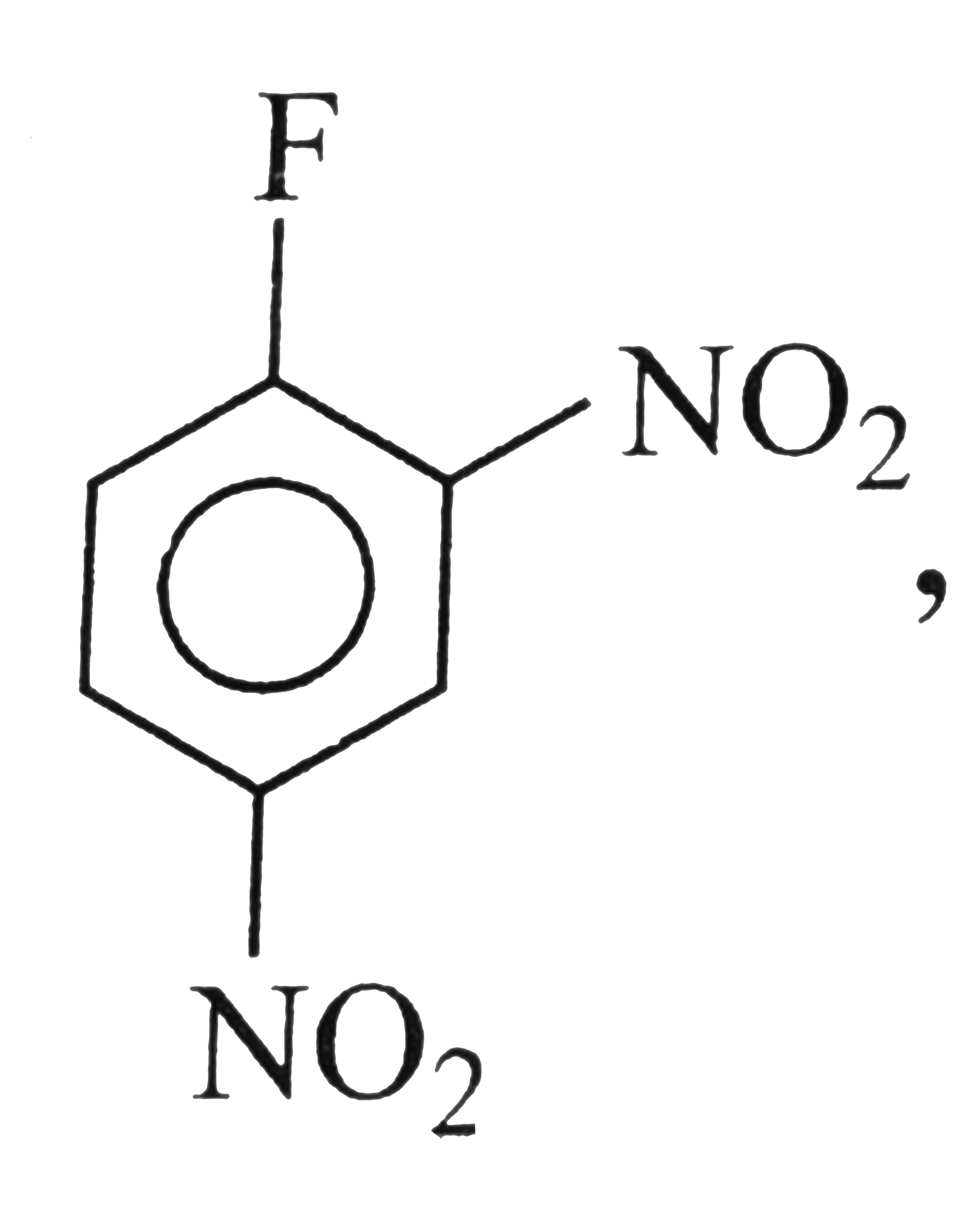
even though it is a por leaving group in alipatic `SN^(-1)` and `SN^(-1)` mechanisms. Exaplin.
III. When reacts with alc. `KCN`, a mixture of ismeric products is obtained. Explain.View Solution
reacts with alc. `KCN`, a mixture of ismeric products is obtained. Explain.View Solution
Illustration questions and complete solutions for chapter AROMATIC COMPOUNDS AND ALKYL AND ARYL HALIDES of CENGAGE CHEMISTRY (ENGLISH) of Class 12
All Exercises from CENGAGE CHEMISTRY Class 12 CHEMISTRY AROMATIC COMPOUNDS AND ALKYL AND ARYL HALIDES
- Archives Assertion-Resoning
- Archives Fill In Theblanks
- Archives Mutiple Correct
- Archives Mutiple Correct Answers Type
- Archives Single Correct
- Archives Single Correct Answer Type
- Archives Subjective
- Archives Subjective Type
- Exercises Assertion-Resoning
- Exercises Assertion-Resoning Type
- Exercises Concept Application
- Exercises Concept Application Type
- Exercises Linked Compreshension
- Exercises Linked Compreshension Type
- Exercises Multiple Correct
- Exercises Multiple Correct Answers Type
- Exercises Single Correct
- Exercises Single Correct Answer Type
- Exercises Subjective
- Exercises Subjective Type
- Illustration
- Solved Examples
- Solved Problems
